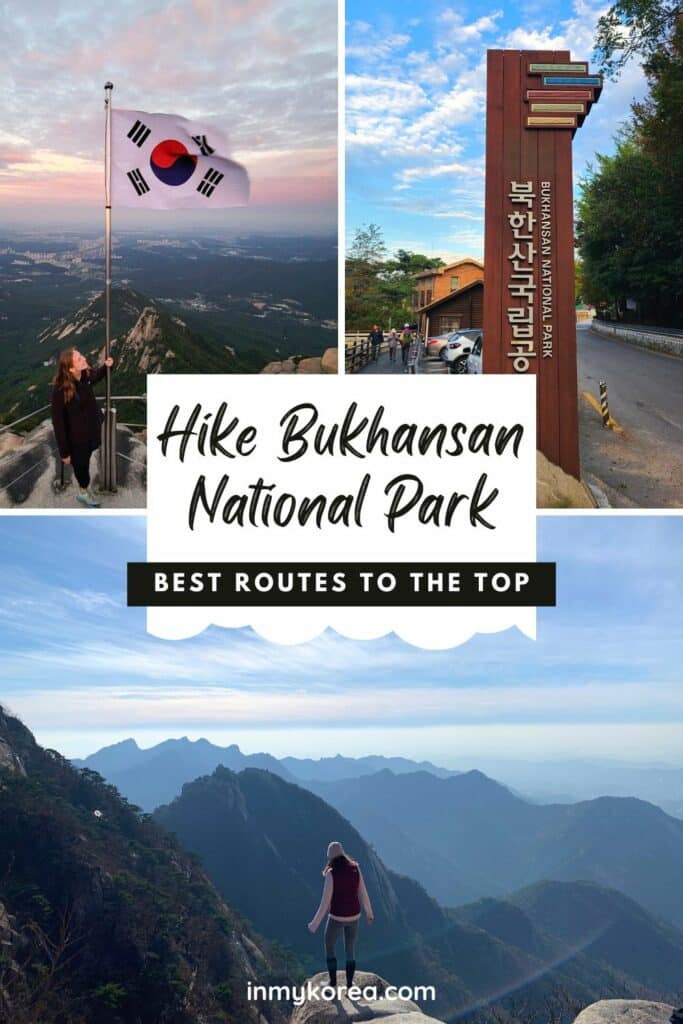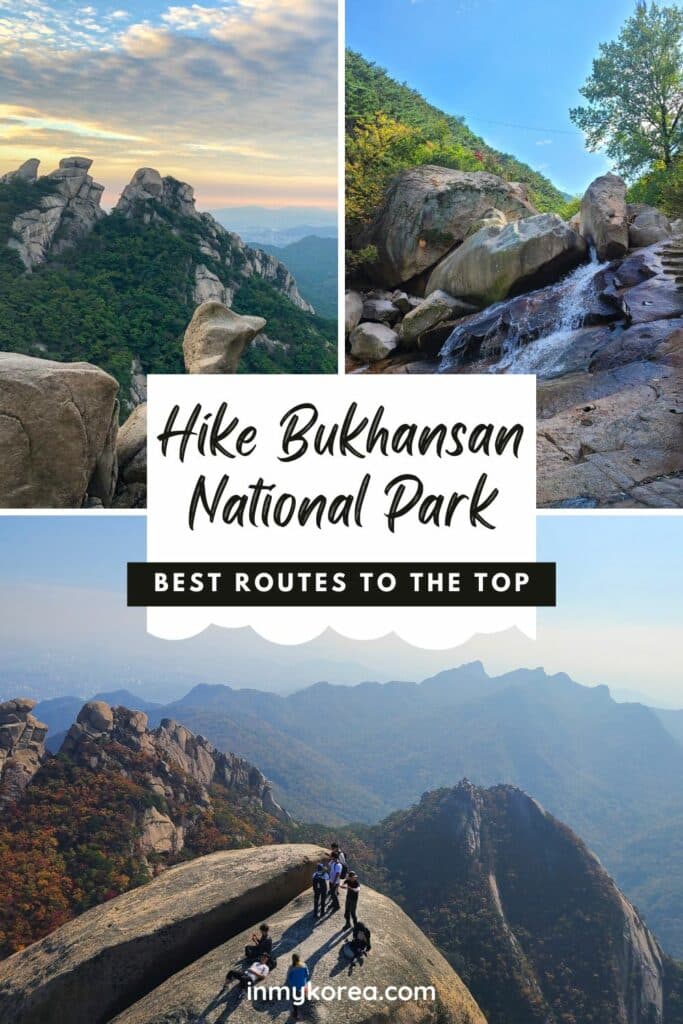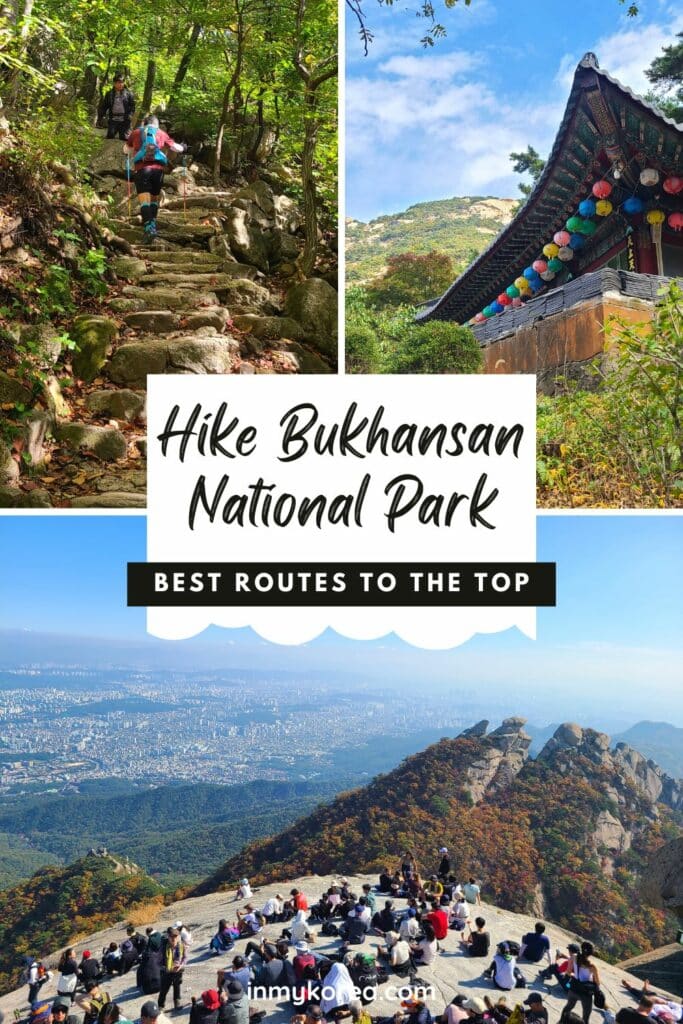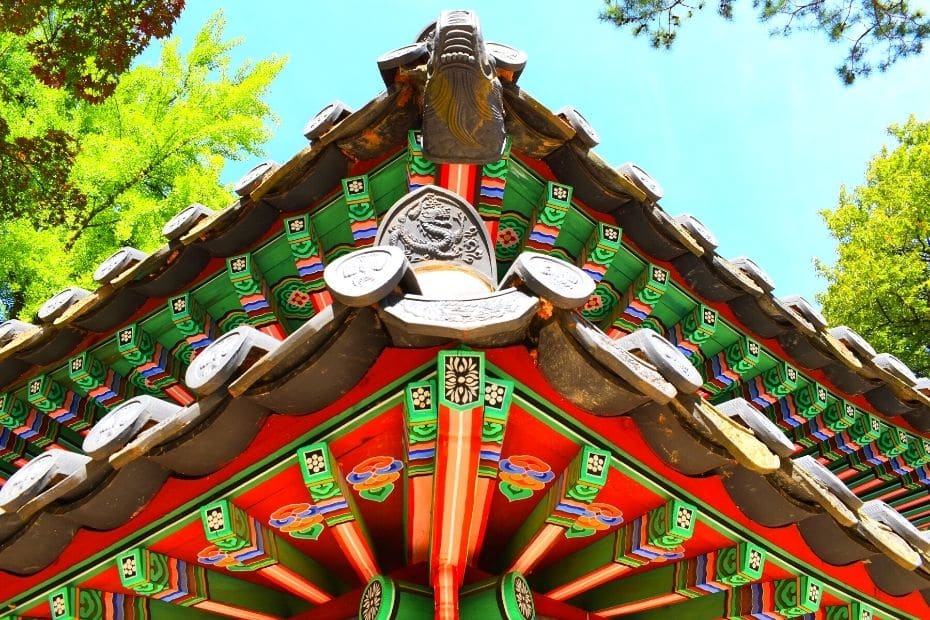One of Seoul’s best hikes is the Baegundae Peak hike in Bukhansan National Park. This day hike will take you past Buddhist temples, along river-filled valleys, up leafy slopes with lush foliage, and onto the rocky peaks with breathtaking views across Seoul. If you only do one hike in Korea, you should hike Bukhansan Baegundae Peak. It’s a perfect day out in Seoul.
As the highest mountain in Seoul, hiking to Baegundae Peak in Bukhansan National Park can be challenging, but is most definitely a rewarding experience. Getting out Seoul’s busy streets and hitting the hiking trails is a refreshing way to exercise and see more of Korea’s mountains and nature.
This guide will help you prepare to hike Bukhansan Baegundae Peak. Find out how to get there, what to wear, what to prepare, and the best Korean restaurants nearby. Discover the best hiking routes to Baegundae Peak from different sides of Bukhansan National Park that will suit your hiking ability.
Affiliate Disclaimer: This site contains affiliate links and I may earn commission for purchases made after clicking these links.
Why Should You Hike Bukhansan’s Baegundae Peak?

Why should you hike Bukhansan’s Baegundae Peak? Because it’s one of the most accessible peaks close to Seoul that will offer you incredible views over the city and of Korea’s gorgeous nature. There are various hiking trails up to Baegundae Peak that each offer unique sights and challenges.
No matter the season, Baegundae Peak in Bukhansan National Park is always a great option for a day hike in Seoul. On your hike to the peak, you’ll be surrounded by fresh green trees in spring and summer, while in autumn you can see beautiful gold, amber, and fiery red fall foliage.
Snowy and icy hikes in winter make the mountain a bigger challenge but nonetheless beautiful. When you complete the hike up Bukhansan, you will be amazed by the view and size of Seoul. Despite Bukhansan being in the north part of Seoul, you can spot Lotte Tower and beyond on a clear day.
The images below should give you an idea of what to expect when you hike to Baegundae Peak in Bukhansan National Park. From the park entrance to the peak, there are lots of lovely sights to take in whichever route you decide to take. Bukhansan is definitely the best place to hike in Seoul.

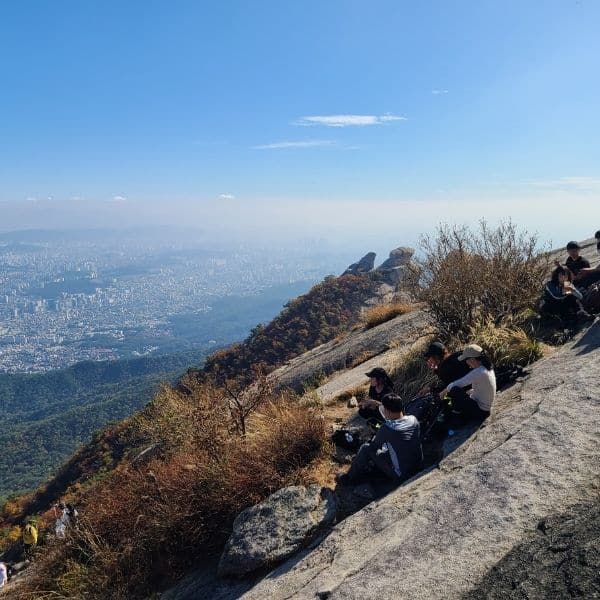
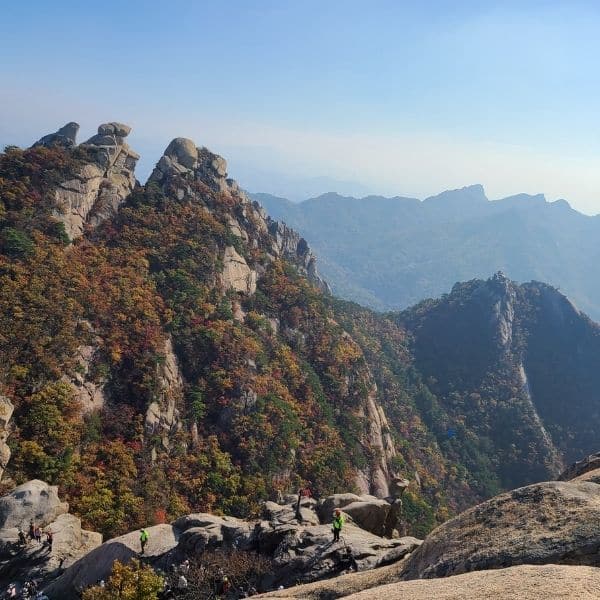
Besides the joy of hiking in Korea, which is always good fun, here are five more reasons you should hike to Bukhansan’s Baeugundae Peak when you visit Seoul.
Views of Seoul from the peak: Baegundae Peak is 280m higher than the Lotte World Tower and offers the best views of Korea’s capital. You can really see just how far and wide Seoul stretches.
Accessible for all levels: Whether you’re an expert hiker who wants a challenge, or a novice hiker who wants to enjoy a slow, steady walk to the top, the Baegundae Peak hike has an option for you.
Beautiful temple scenes: Bukhansan National Park is blessed with several beautiful temples, including the 1,100 year old Doseonsa Temple which is the start point for one of the hiking trails.
Stunning nature throughout the national park: Expect to see countless trees, bushes, plants, rocks, streams, and animals as you hike to Baegundae Peak, which offer incredible views year round.
Interesting historic sights to learn about: as well as ancient Buddhist temples, you can also see historic sights on the hike to Baegundae Peak, including parts of Bukhansanseong Fortress.
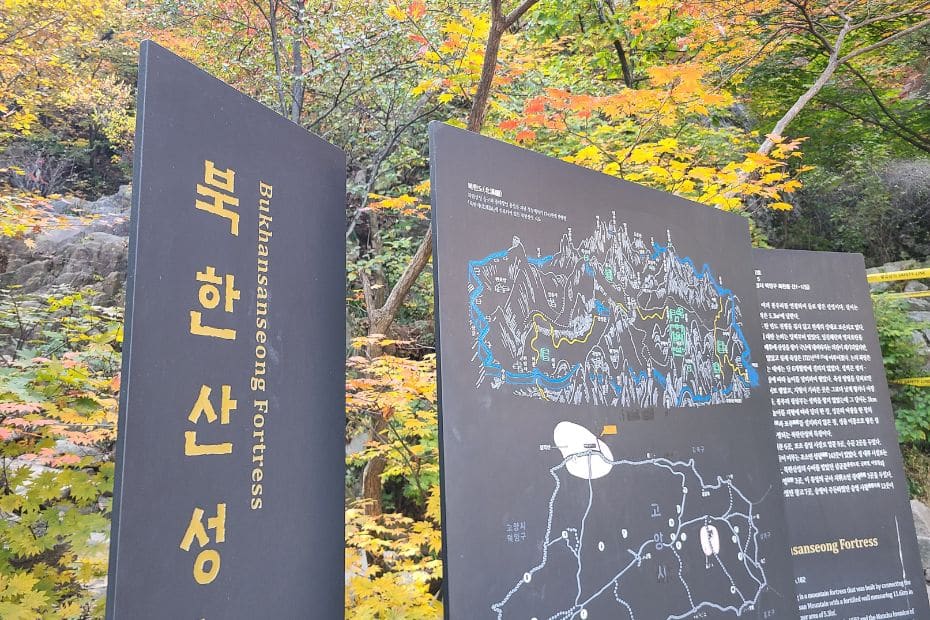
Non-Hikers: Walk The Bukhansan Dulle-gil Trekking Route

Don’t feel up to the challenge of hiking to Baegundae Peak but still want to explore the nature and history of Bukhansan National Park? Then take the Bukhansan dulle-gil (trekking path) around the outside of the national park instead. There are multiple paths to take around the park.
As the Korea National Park Service states, the Bukhansan dulle-gil is “a path where history, culture, nature, and humans come together in harmony.” The dulle-gil courses are signposted and will guide you around the foothills of the mountains. Unfortunately, these are mostly in Korean.
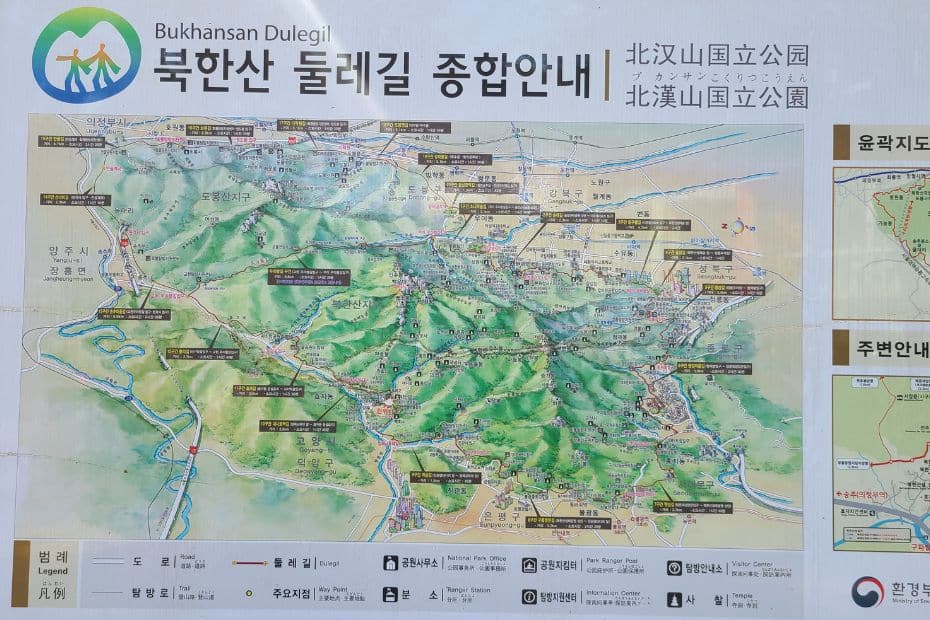
Need Help Doing A Hike To Baegundae Peak?
I hope that this article will provide you with lots of information to help you hike Bukhansan’s Baegundae Peak from a range of starting locations. However, if you still feel like you need help to hike to Baegundae Peak, then why not book a tour to the peak and take all the hassle out of hiking.
This private hiking tour to Baegundae Peak offers you the chance to create a hiking route to the top based on your own fitness levels and experience. A guide will show you the way to go, tell you about the park, and collect you and drop you off at your hotel on the day of the hike.
I believe that the Baegundae Peak hike is certainly possible for most people of reasonable fitness and there are multiple courses to the peak that offer different levels of challenge, which will be covered in the next section of this guide. Keep reading to discover the best hiking trail to Baegundae Peak.
Planning to visit Korea? These travel essentials will help you plan your trip, get the best deals, and save you time and money before and during your Korean adventure.
Visas & K-ETA: Some travellers to Korea need a Tourist Visa, but most can travel with a Korean Electronic Travel Authorisation (K-ETA). Currently 22 Countries don’t need either one.
How To Stay Connected: Pre-order a Korean Sim Card or a WiFi Router to collect on-arrival at Incheon Airport (desks open 24-hours). Alternatively, download a Korean eSIM for you travels.
Where To Stay: For Seoul, I recommend Myeongdong (convenient), Hongdae (cool culture) or Gangnam (shopping). For Busan, Haeundae (Beach) or Seomyeon (Downtown).
Incheon Airport To Seoul: Take the Airport Express (AREX) to Seoul Station or a Limo Bus across Seoul. Book an Incheon Airport Private Transfer and relax to or from the airport.
Korean Tour Operators: Tour companies that have a big presence in Korea include Klook, Trazy, Viator, and Get Your Guide. These sites offer discounted entry tickets for top attractions.
Seoul City Passes: Visit Seoul’s top attractions for free with a Discover Seoul Pass or Go City Seoul Pass. These passes are great for families and couples visiting Seoul – you can save lots.
How To Get Around: For public transport, grab a T-Money Card. Save money on Korea’s high speed trains with a Korea Rail Pass. To see more of Korea, there are many rental car options from Klook, EconomyBookings, and RentalCars.
Travel Money: Use money exchanges near Myeongdong and Hongdae subway stations for the best exchange rates. Order a Wise Card or WOWPASS to pay by card across Korea.
Flights To Korea: I use flight comparison sites such as Expedia and Skyscanner to find the best flights to Korea from any country. Air Asia is a good option for budget flights from Asia.
Travel Insurance: It is important to insure your trips to protect yourself against the unexpected. World Nomad is a specialized travel insurance provider with options for different coverage for travellers from around the world. You can also purchase cover when you are already travelling.
How To Learn Korean: The language course from 90 Day Korean or Korean Class 101 both have well-structured lessons and lots of useful resources to help you learn Korean.
The Best Hiking Trails To Baegundae Peak In Bukhansan

Before you start your hike to Baegundae Peak, it is necessary to decide which route you will take to the top. There are several starting points that lead to the peak and in this article I will cover three of the best trails to Baegundae Peak and back, including one that crosses across the whole park.
These trails all meet near a fortress gate before the most difficult section of the hike – getting up the rocky section to reach Baegundae Peak. If you are using public transport, it is possible to go up one way and down the other. However, this is not possible if you are travelling by car for obvious reasons.
The three hiking trails for Baegundae Peak that this article will introduce you to are:
Baegundae Peak from Doseonsa Temple: This is the shortest and easiest route to get to the peak and starts on the eastern side of the park. Good for those with limited time to hike.
Baegundae Peak from Bukhansan Fortress Entrance: This trail splits halfway and allows you to choose a longer, easier route, or a shorter, more difficult route to reach the peak. Both are stunning.
Bukhansan Fortress To Baegundae 2 Ranger Station via Baegundae Peak: This is a hiking trail to Baegundae Peak that starts at one end of the park and finishes at the other side of the park.
These trails all go to Baegundae Peak but differ in length, time, and effort. There are plenty of other hiking routes in the national park, but I can’t cover them all in this article. If you want to hike other parts of Bukhansan, you can explore more paths from the official National Parks of Korea website.
Hike To Baegundae Peak from Doseonsa Temple
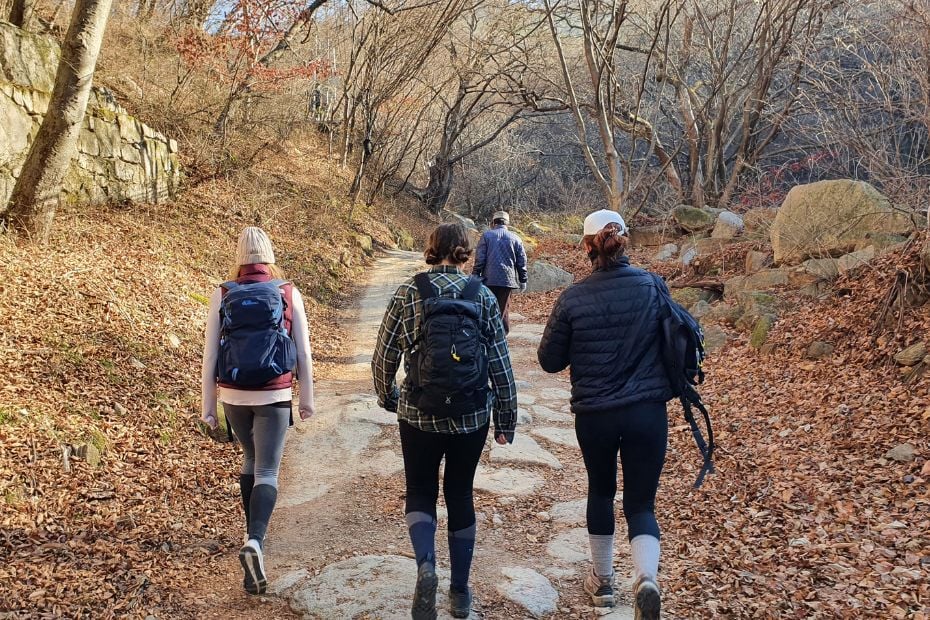
Length: 2.6km (one way)
Time: 2.5 -3 hours (return)
Difficulty: 3/5
Starting Point: 삼각산 도선사
This is the shortest hike to Baegundae Peak and can be completed in under 3 hours. The Doseonsa Temple route begins at the east side of the mountain at the 1,100 year old Doseonsa Temple, which I recommend exploring before you hike as it’s an important treasure of Bukhansan National Park.
At the entrance to the hiking trail there is a public toilet and some vending machines. I wouldn’t recommend waiting to buy hiking supplies from the vending machines, buy them before you set off. Stop at a convenience store before travelling to buy some gimbap, water, and other snacks.
To help you work out how long and far the hike from Doseonsa Temple to Baegundae Peak is, check out the annotated map below, taken from the hiking trail sign in Bukhansan National Park. Fortunately, all hiking signs and maps are in both English and Korean in Bukhansan National Park.

About The Hiking Trail From Doseonsa Temple
The trail begins winding up through the forest, offering views of Seoul behind you through the trees and Bukhansan’s other peaks in front. You’ll walk for 1.1km towards 용암문 (Yong-am-mun), which is an old fortress gate that’s part of Bukhansan Fortress. This section is rated as ‘intermediate’.
Take the 1.2km path to the right of Yong-am-mun gate and head towards the 백운봉암문 (Bae-gun-bong-am-mun), another fortress gate where the hiking paths to Baegundae Peak meet before the final ascent. This section is part of the ‘easy’ route from Bukhansan Fortress Entrance, but is ‘advanced’.
As you hike along this section, you’ll pass over Yong-am-bong (Yongam Peak), which is a bare, rocky peak with good views over the city to the south. You’ll walk around the sides of other peaks on your way and there are sections where you’ll need to scramble up and over large rocks in the path.
As the routes join together you should be prepared for the most difficult part of the hike. The last 300 metre section of the hike up to Baegundae Peak will require you to pull yourself up either using the metal railing or rope provided. This final section is steep and should be approached with caution.
I’ll discuss more about the final section of the Baegundae Peak hike after introducing the other trails.
How To Get To The Doseonsa Temple Start Point
The starting point of this trail is accessible by public transport and by car. The nearest public transport stop is Bukhansan Ui subway station, which is actually quite far from Doseonsa Temple, but the walk is very pleasant and passes some traditional restaurants and shops for food before you hike.
The road that leads to Doseonsa Temple is a long, gradual incline and takes an hour or so to walk along from Bukhansan Ui station. Keep following the road straight and at the end there should be signposts to the temple. For an alternative start point, head to nearby Baegundae 2 Ranger Station.
By Public Transport: Take a bus (Dobong 02, Dobong 05, 101,109,151) or subway (Ui-sinseol line) to Bukhansan Ui subway station (북한산우이). From this point you can either walk, which takes 1 hour along the road, or you can take a taxi (15 minutes) to the starting point.
By Car: It is possible to drive to the starting point and park your car by the entrance. However, throughout the day the car park gets very crowded, and it may be difficult to find a spot. Use the address below in Korean to find your way by map (I recommend Naver Maps).
Address in Korean: 서울특별시 강북구 삼양로173길 504
Hike To Baegundae Peak From Bukhansan Fortress Entrance
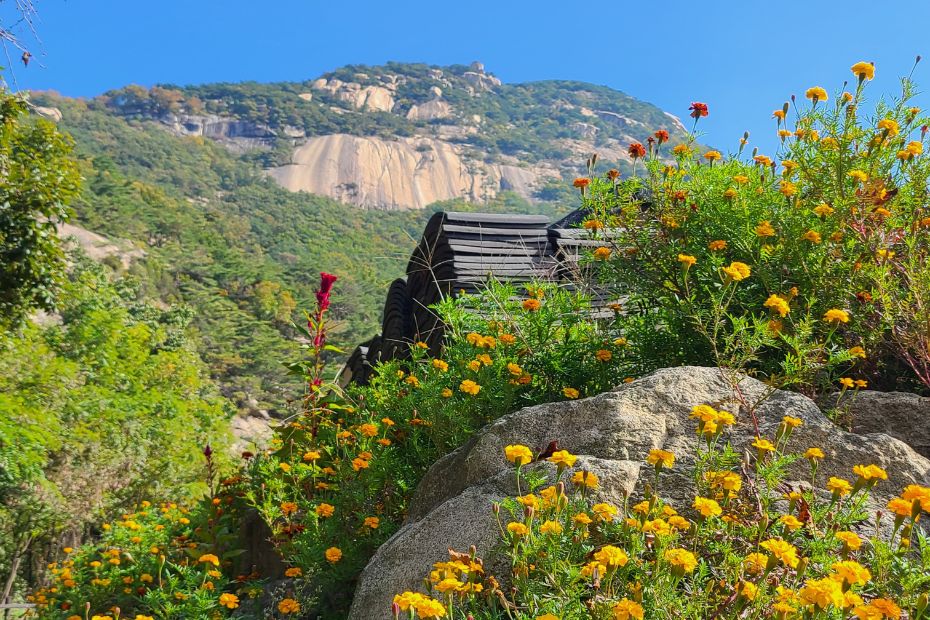
Starting Point: 북한산성입구
There are two main hiking paths to Baegundae Peak from the Bukhansan Fortress Entrance, one is shorter but more difficult while the other is longer but easier. Both arrive at the same fortress gate as the Doseonsa Temple path before the final ascent to Baegundae Peak.

These paths both follow the same route from the national park entrance, but split after 1.2km when you arrive at Borisa Temple (marked as ‘You Are Here’ in the image above). There are multiple paths to Borisa Temple from the entrance, I’ve highlighted my favourite one – the orange path.
The path from Bukhansan Fortress Entrance to Borisa Temple is very pleasant, passing along rivers, past temples, and along wooden walking paths and stony lanes. The path is marked as ‘intermediate’, but isn’t difficult and should only take about 30-40 minutes.
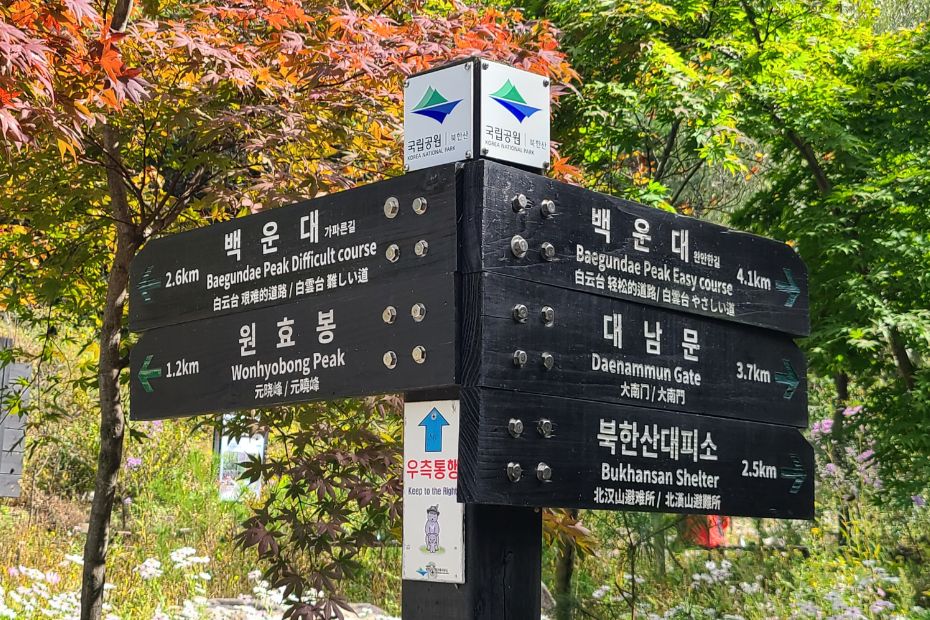
The next two sections will describe the different paths from Borisa Temple – the Baegundae Peak Easy Course and the Baegundae Peak Difficult Course. At Borisa Temple, you can see a signpost like the one above that will show you the two different courses. Follow these to Baegundae Peak.
When you’re at Borisa Temple, I highly recommend using the toilet facilities as these are the last toilets if you’re taking the difficult route to the peak. Like many toilets in Korea’s national parks, these are clean and have good facilities. Toilets higher up in national parks aren’t always as good, however.

Baegundae Peak Easy Course From Bukhansan Fortress Entrance
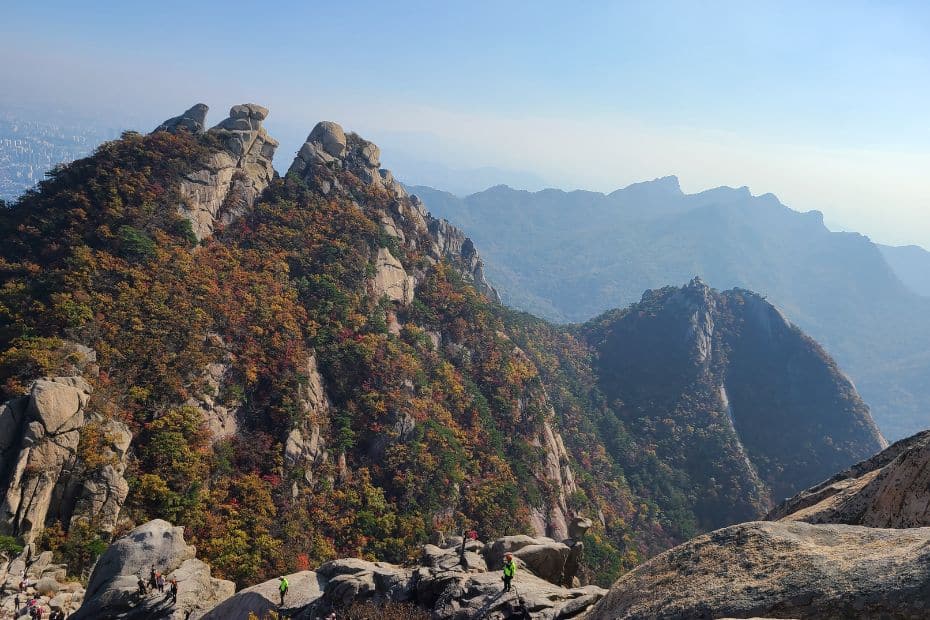
Length: 6.9km (one way)
Time: 6 hours (return)
Difficulty: 3/5
After you arrive at Borisa Temple, which can also be reached by heading for the Bukhandong History Museum (북한동역사권), start the Baegundae Peak Easy Course. This path continues to head east from the course’s start point, heading past several temples in the foothills before you start the ascent.
The map below shows the various temples you’ll pass in the first few sections of this course. This route follows the stream for some time, providing a more relaxing hike up the mountain and great views. This route is a longer hike but is much easier than the other trail from this entrance point.
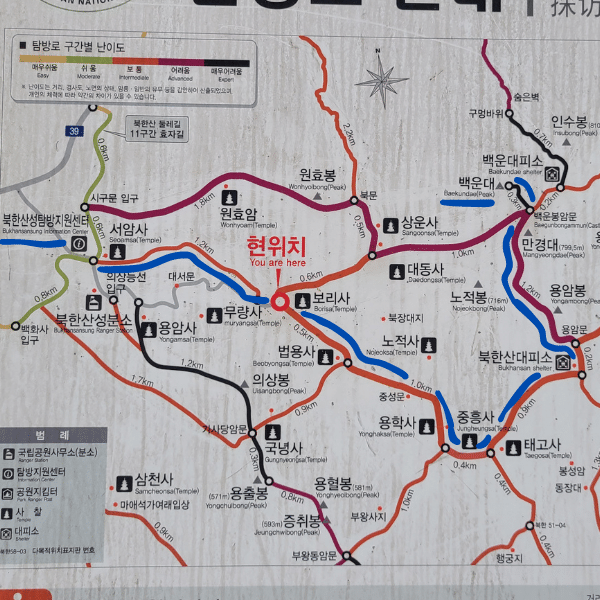
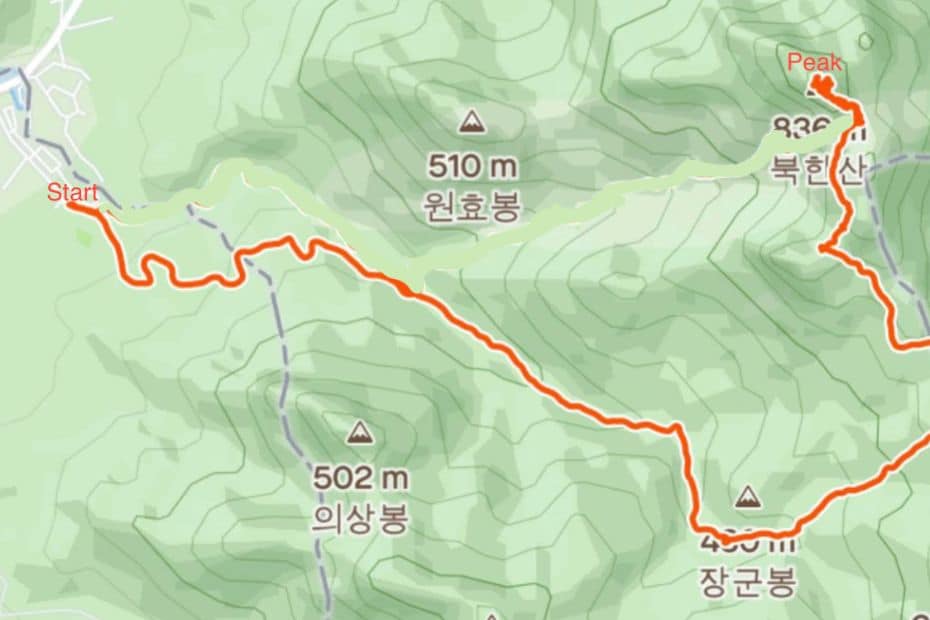
Although there will be times where the route is harder, the trail slowly winds up the mountain and overall, it is the easiest route up. The first few sections are broken down in to 0.5km, 1.0km, and 0.4km trails with each section ending at a temple, with the last one being Taegosa Temple.
From this point the path starts to ascend more steadily and the next 0.9km from Taegosa Temple to the Bukhansan Shelter (북한산대피소) passes along forested fortress walls with rocky steps upwards. The shelter is a good place to stop for a bite to eat and rest before the more challenging sections.
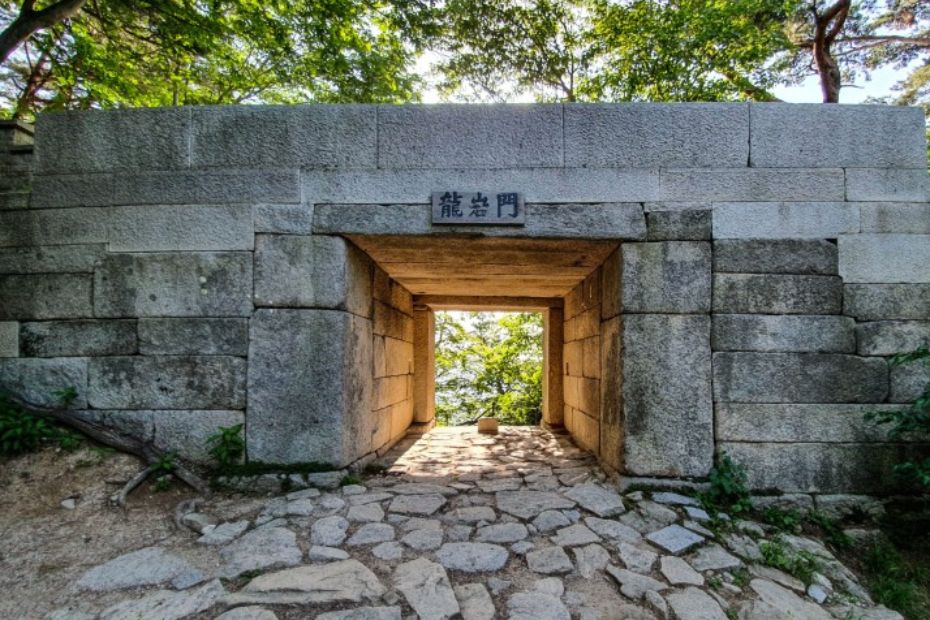
After the Bukhansan Shelter, it’s a short trek to Yong-am-mun (용암문) fortress gate and then 1.2km towards 백운봉암문 (Bae-gun-bong-am-mun), another fortress gate where all the hiking paths to Baegundae Peak meet before the final ascent. This section is advanced as it’s rocky underfoot.
As you hike along this section, you’ll pass over Yong-am-bong (Yongam Peak), which is a bare, rocky peak with good views over the city to the south. You’ll walk around the sides of other peaks on your way and there are sections where you’ll need to scramble up and over large rocks in the path.
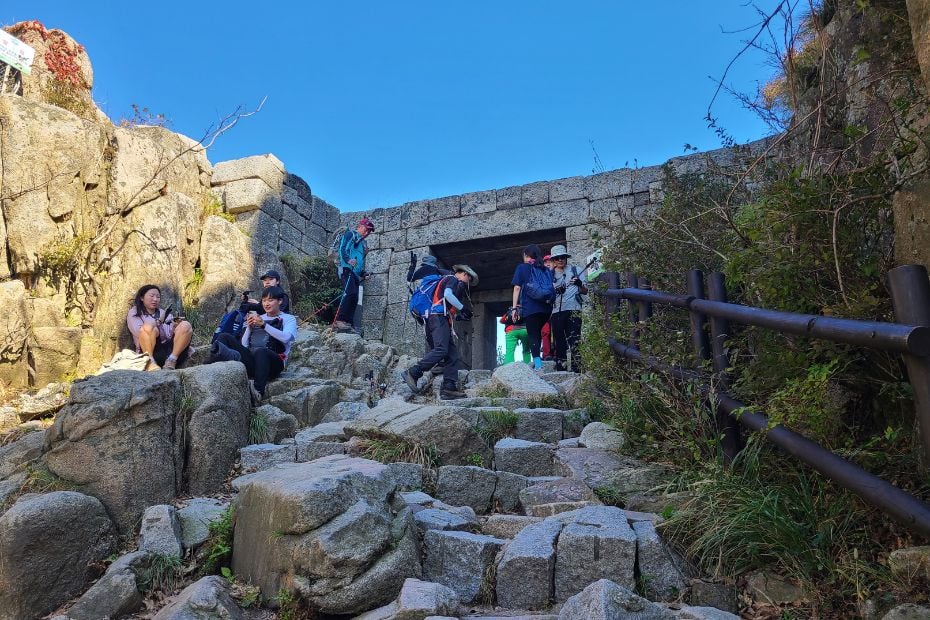
The Bae-gun-bong-am-mun (백운봉암문) fortress gate (pictured above) is where the easy and difficult courses meet before the final ascent to Baegundae Peak, which I’ll describe in a later section. I recommend resting here as the final ascent to the peak is tough.
Baegundae Peak Difficult Course From Bukhansan Fortress Entrance

Length: 4.8km (one way)
Time: 4-5 hours (return)
Difficulty: 4/5
If you are up for a challenge and wish to take the shortest route up, then the Baegundae Peak Difficult Course is for you. As you cross the bridge you need to go along the path to the left and follow the signs for the Baegundae Peak Difficult Course (백운대). Be prepared for a short, steep hike to the top.
This route involves long periods of steep incline that will make those leg muscles work hard. However, it is a faster route up to the top. As you can see from the map below, there are two sections that lead up to the Bae-gun-bong-am-mun (백운봉암문) fortress gate before the final ascent.
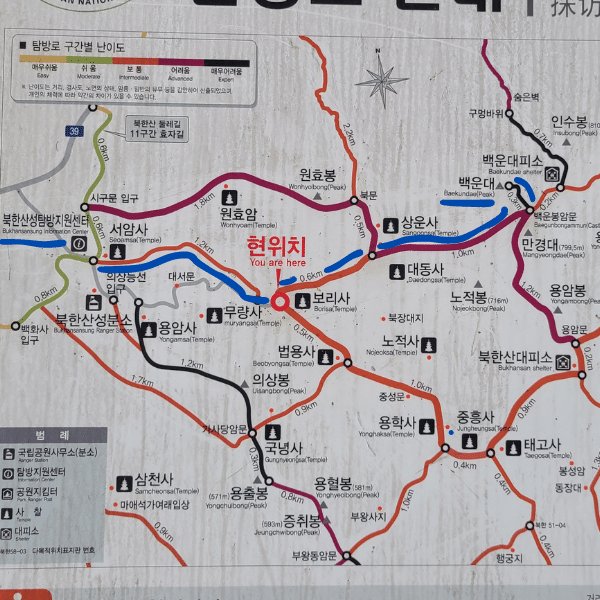
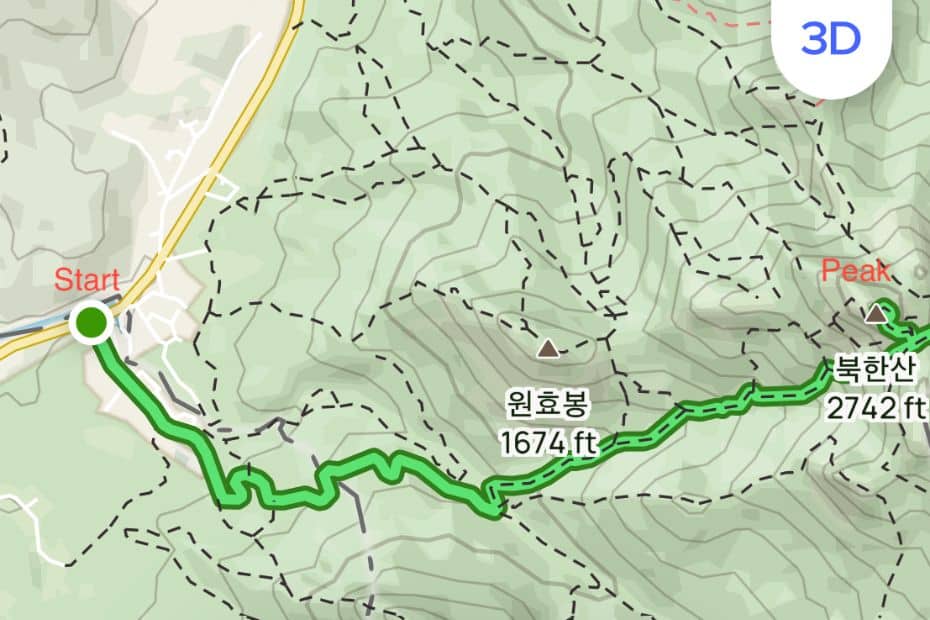
The first 0.6km of this trail goes through the forest and the path is made up of rocky stones (pictured below) or dirt tracks that don’t ruin the beautiful nature of the park. This section is ‘intermediate’ and not too long, but the rocks may be trouble for some who have problems on difficult terrain.
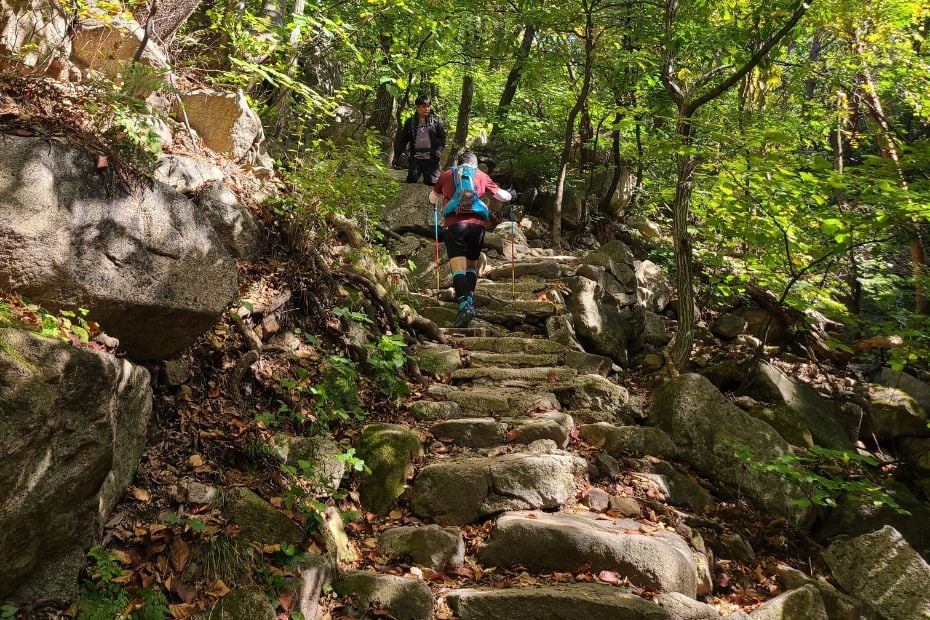
As the forests on this route are quite thick, especially from late-spring to autumn, the views on the way to Baegundae Peak are sometimes blocked by the trees. Whenever there is a break in the foliage, however, there are great views. These viewing points are a good place to take a scenic break.
Once you get onto the second section of the Baegundae Peak Difficult Course, the paths start to get steeper and more difficult. You will find more wooden stairways (pictured below) and paths where you have to climb over (or around) large rocks. This section is ‘only’ 1km long, but is ‘advanced’.
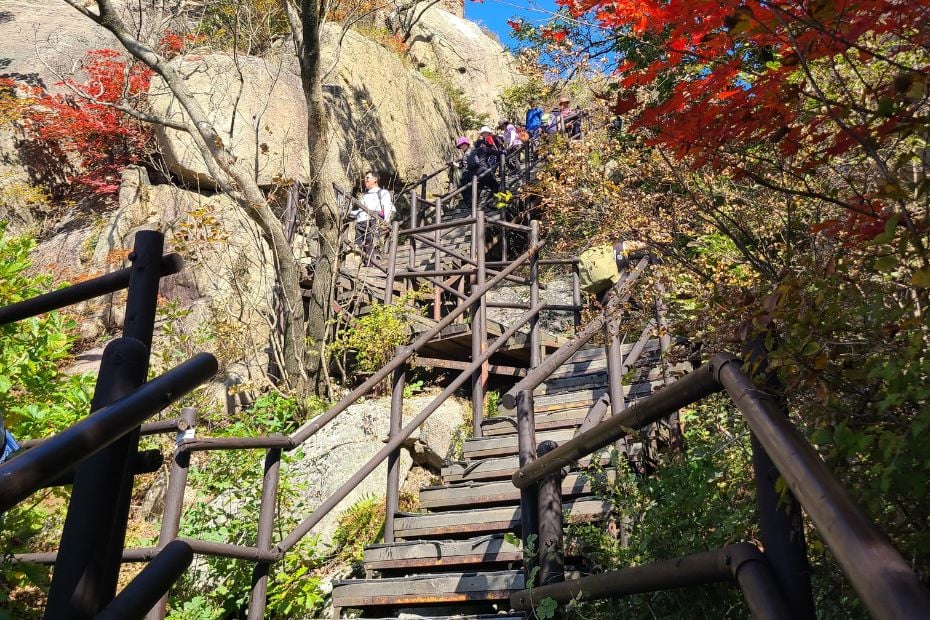
As you hike towards Baegundae Peak, you might notice some wild animals. Bukhansan National Park is home to various wildlife, including deer, wild boars, squirrels, snakes, and other creatures. Watch out for snakes if you hike in autumn as they hide under the leaves and may surprise hikers.
You will also see a few wild (domestic) cats that have made Bukhansan their home, like the black and white cat in the picture below. These cats may get defensive if they have kittens, but generally don’t cause any problems. You can even see them at the peak, looking for donations from dining hikers.
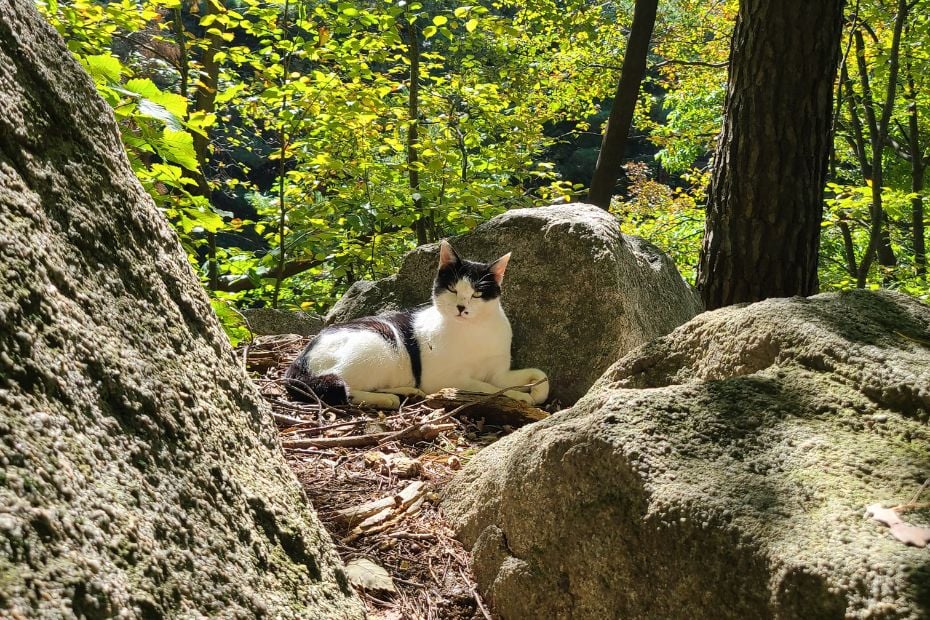
As with the other hiking routes to Baegundae Peak, the path ends at Bae-gun-bong-am-mun (백운봉암문) fortress gate before the final ascent to Baegundae Peak.
How To Get To The Bukhansan Fortress Entrance Start Point
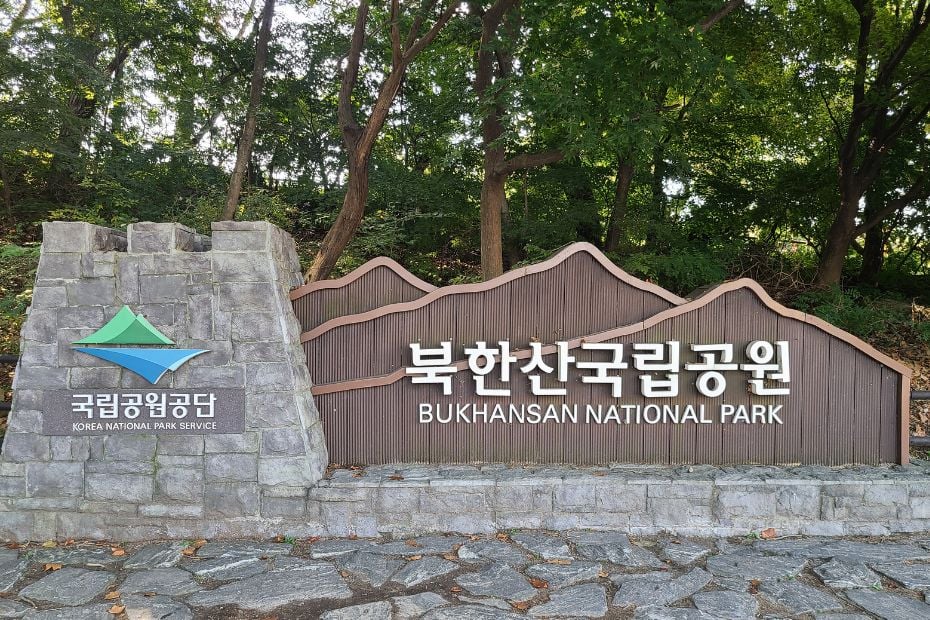
The Bukhansan Fortress Entrance is much easier to reach by car and public transport as it’s closer to the city than the Doseonsa Temple start point. There are buses that stop outside the entrance and a subway stop (Gupabal Station) about 15 minutes away by bus or taxi.
There are a lot of restaurants, cafes and shops in this area, which is why it’s a more popular starting point to hike Baegundae Peak than Doseonsa Temple. You can stock up on food from convenience stores, grab a coffee for hiking energy, or pick up food from food stalls to take with you.
The walk from the bus stop / car park to the national park entrance sign (above), which is the starting point for this hike, takes about 10 minutes. You’ll need to pass by all the restaurants and shops first. Head left from here and you’ll see signs (like the one below) and signposts pointing to the peak.
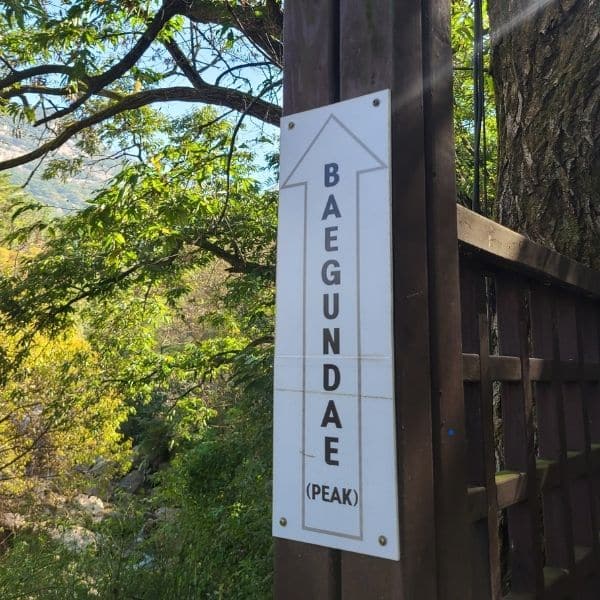
By Public Transport: Take the subway (line 3) to Gupabal Station (구파빌역). Leave from exit 1 of the station and then wait for bus 34 or 704 to the start point (Bukhansan Fortress Entrance 북한산성입구). If there are many people waiting, take a taxi. A taxi should cost about 6,000 KRW and will be faster.
Once you get off the bus at Bukhansan Fortress Entrance (북한산성입구), which should take about 15 minutes, keep walking in the same direction as the bus and turn right at the first junction. Walk straight along the road up to the trail entrance and that is where your adventure will begin.
By Car: It is possible to drive to the starting point (Bukhansan Fortress Entrance 북한산성입구) and park your car by the entrance. There are lots of parking spaces available. However, there are also lots of restaurants at the start point so it can be busy at times, especially on the weekends.
Address in Korean: 서울특별시 은평구 진관동 북한산성입구주차장
Bukhansan Fortress Entrance To Baegundae 2 Ranger Station
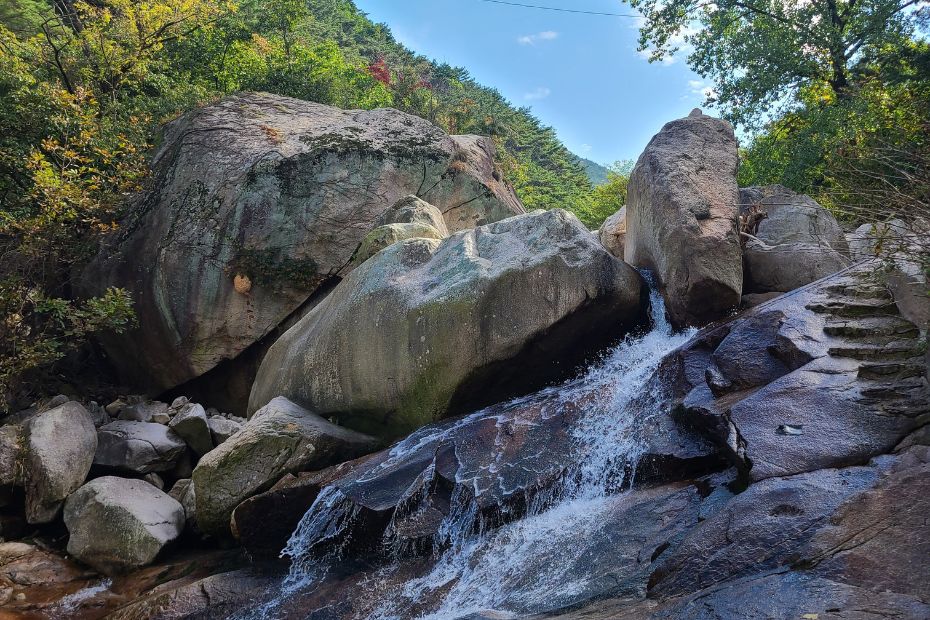
Length: 6.3km
Time: 5-6 hours
Difficulty: 3/5 or 4/5
The third route is a one-way path that starts from the Bukhansan Fortress Entrance, goes to Baegundae Peak, then descends down the opposite side of the park towards the eastern part of Seoul. The end is close to Doseonsa Temple, but ends at the Baegundae 2 Ranger Station instead.
I recommend starting at the Bukhansan Fortress Entrance as it’s more convenient for stocking up with hiking supplies at the start of the hike. The hike down from Baegundae Peak to the Baegundae 2 Ranger Station is also short and not that steep, making it a nice end to the hike.
The path from the Bukhansan Fortress Entrance to Baegundae Peak can follow the aforementioned Easy Course (3/5) or Difficult Course (4/5). I’ve highlighted the Baegundae Peak Difficult Course on the map below as it’s faster and this is an all day hike through Bukhansan National Park.
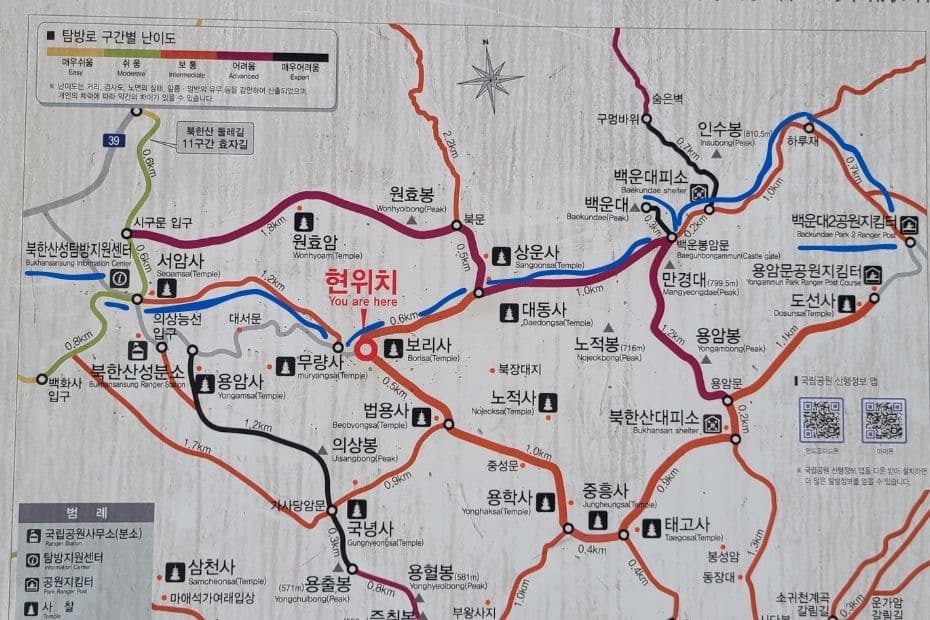
Although this is an all-day hike, it’s not any more difficult than the return hike starting and ending at the Bukhansan Fortress Entrance to Baegundae Peak. There is actually less ‘advanced’ course as the path down from Baegundae Peak to the ranger station is ‘intermediate’ and not that steep.
If you start hiking around 9am, you should reach Baegundae Peak around noon, maybe later depending on which course you chose from Borisa Temple. The descent from the peak takes about 90 minutes and the final sections allow you to maintain a good pace all the way to the bottom.
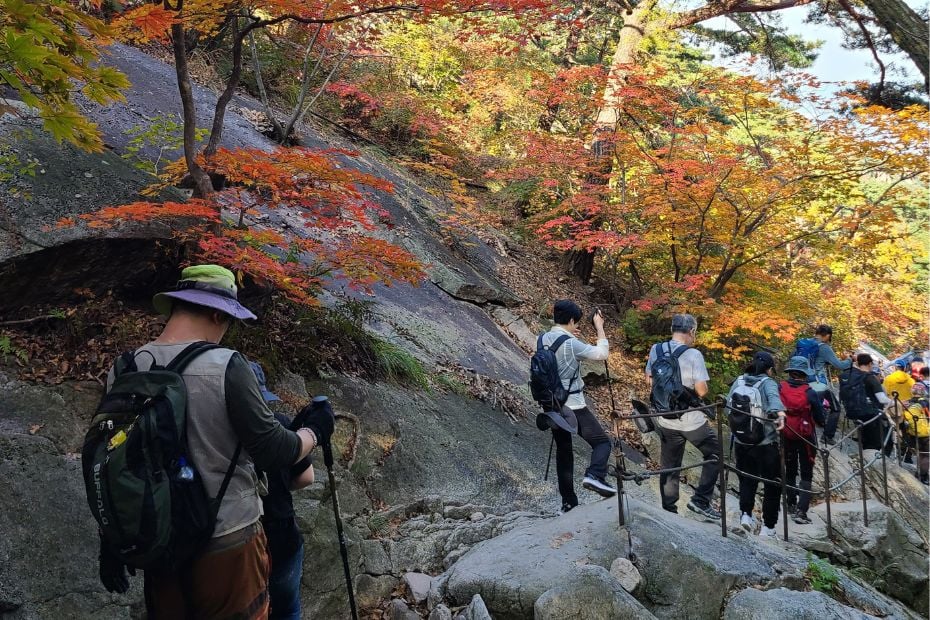
The path after Baegundae Peak starts with rocky steps and changes into wooden steps from time to time when the pathway is too slippery. After the first 1.0km of the descent, the path resolves into a gravel or dirt path that’s easy to walk along. There are great views of Seoul ahead of you.
Towards the end of the second section you’ll pass various temples, such as Insuam (pictured below), as well as traditional Korean buildings and park management facilities. At the end of the hike the path changes to paved road and there are various pathways leading back to the city.
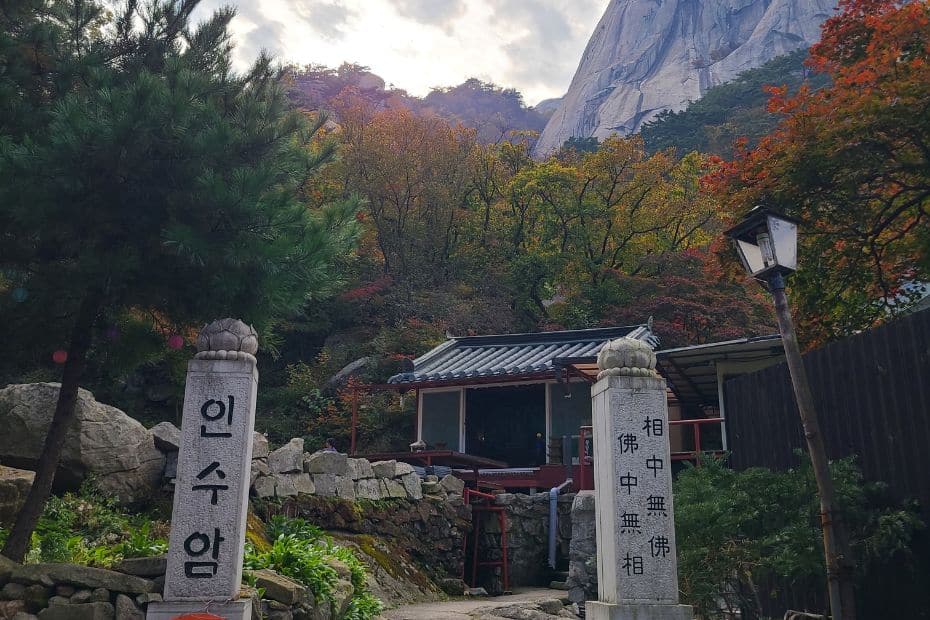
Either walk to the ranger station, or leave the path early and visit the Bukhansan National Park Baegundae Visitor Center. This is closer to Doseonsa Temple and has a public toilet. There are also vending machines to replenish your water supplies.
From here, walk back to Bukhansan Ui Subway Station for buses and subway connections back into central Seoul. The walk takes about an hour and is the same path that leads to Doseonsa Temple. There are restaurants in this area where you can enjoy traditional Korean hiking foods.
Baegundae Visitor Center Address: 서울특별시 강북구 우이동 삼양로173길 462
The Final Ascent To Baegundae Peak Summit
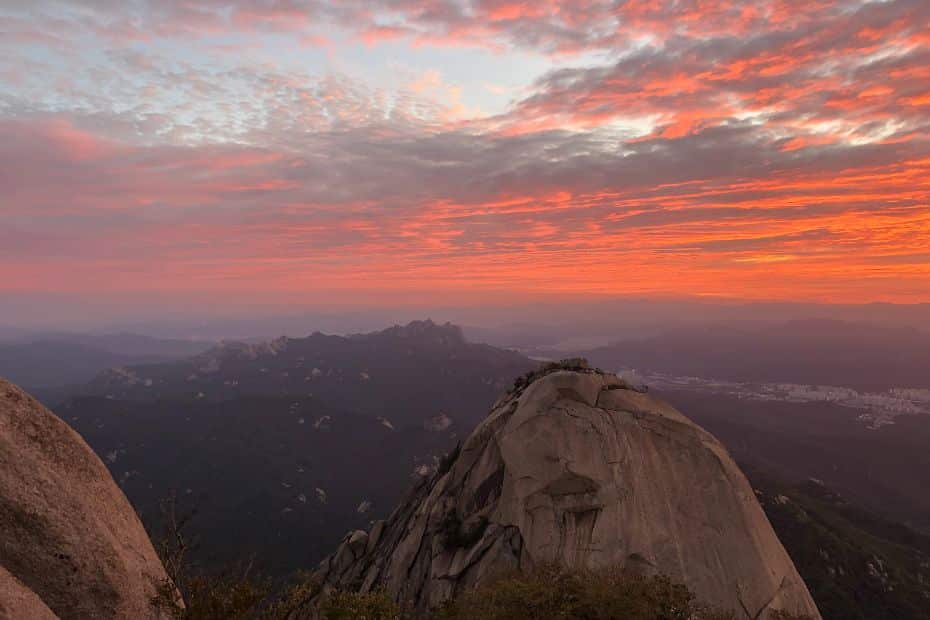
The final ascent to Baegundae Peak is the same for all hiking routes as it’s a one-way path off the main routes. It’s tougher than the other parts of the hike and deserves its own section as there are many things to be careful for. There are also lots of things to enjoy from the top, not least the views.
After you arrive at the Bae-gun-bong-am-mun (백운봉암문) fortress gate, you should turn left (west) towards Baegundae Peak, following the fortress walls before stepping above them. The path (shown below) is narrow for a while, but soon opens into the rocky slopes that make up the final ascent.

The next section isn’t for the faint of heart. There are a few open areas before the main climb to the peak, but they quickly give way to steps carved into the rock with metal railings being the only thing stopping you from dropping to the foothills below. There are the occasional ropes to help you, too.
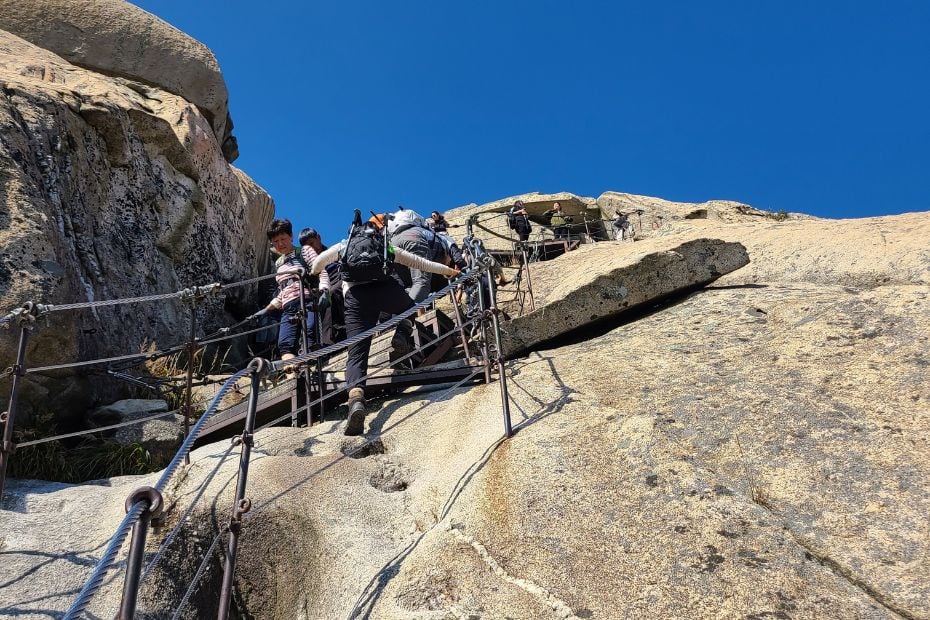
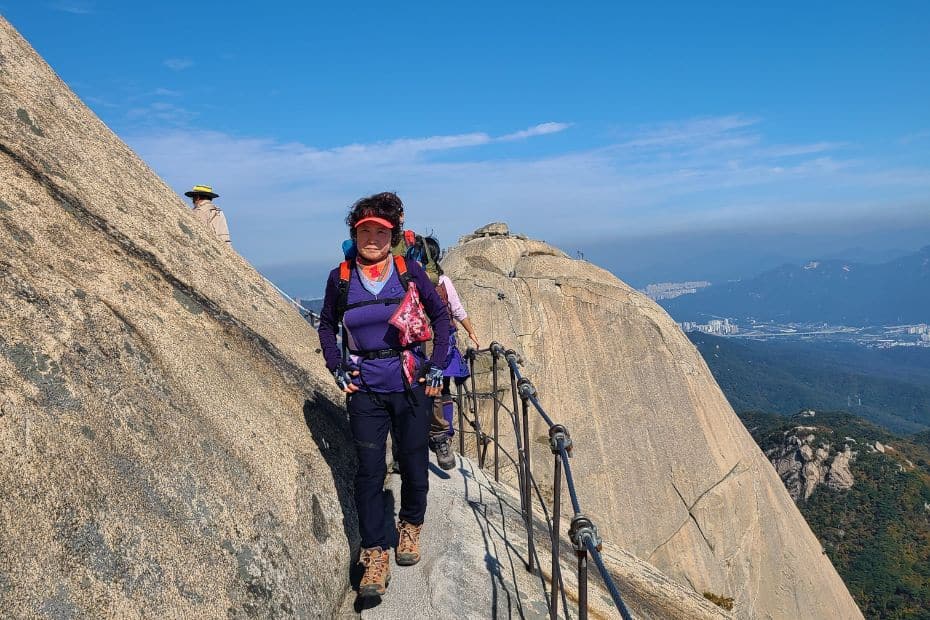
As Baegundae Peak is one of the most popular hiking destinations for hikers in Seoul, especially in autumn foliage season, expect this part of the hike to be crowded at times. Once you’ve braved the scary walk along the edge of the cliff, there is a large slab of rock to rest on below the peak.
This large rock, and some smaller areas around it, aren’t the actual peak of Baegundae – that’s a bit further up and can take a long time to get to depending on the number of people hiking that day. Take a break and enjoy the views before pulling yourself up to the peak. This is a great place to have lunch.
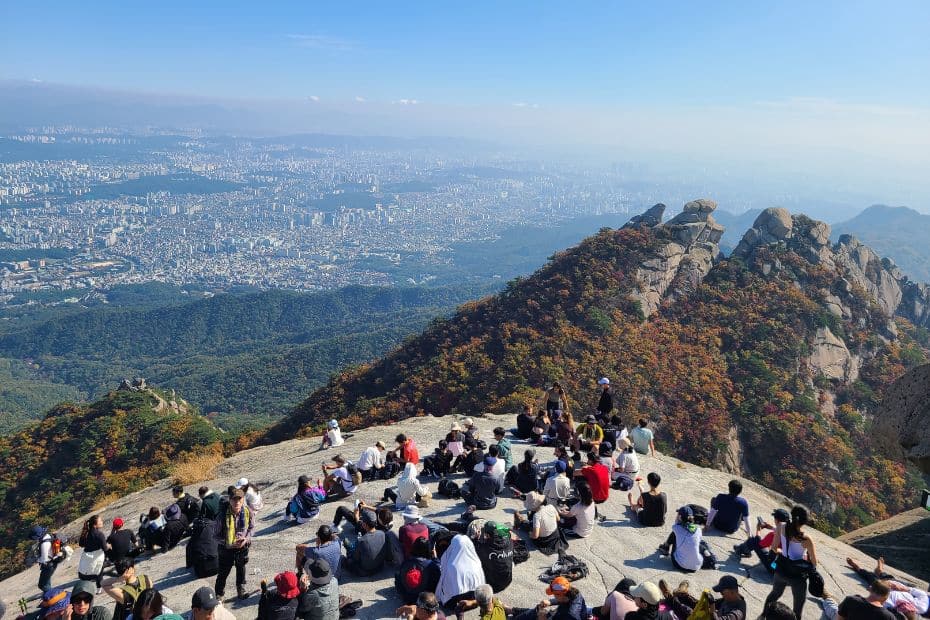
The last few steps to the very peak of the mountain can take longer than the previous section as the views are incredible and everyone wants to take a selfie with the peak-stone, which shows the name of the peak and height. There’s also a Korean flag, which adds to the scene.
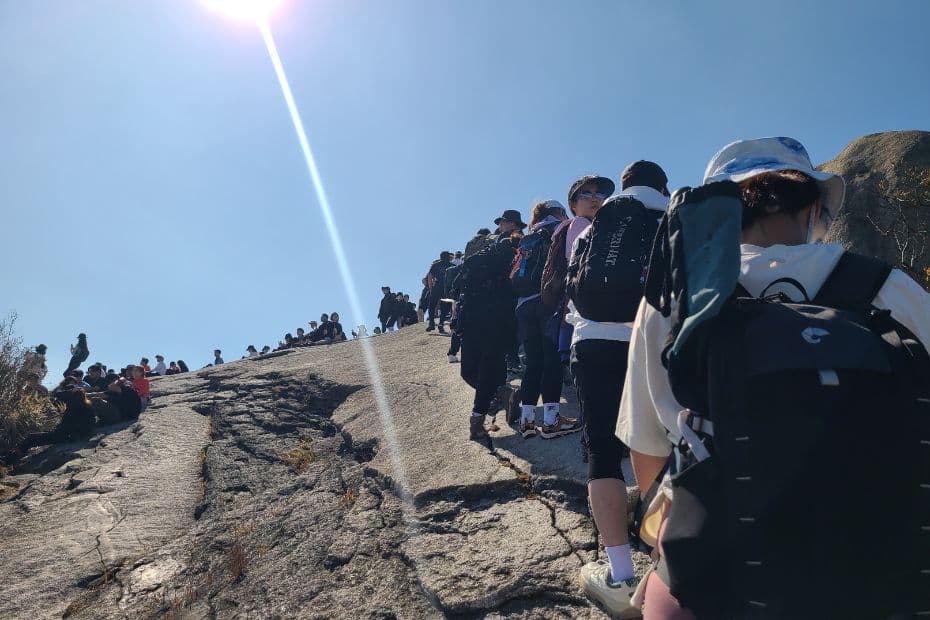
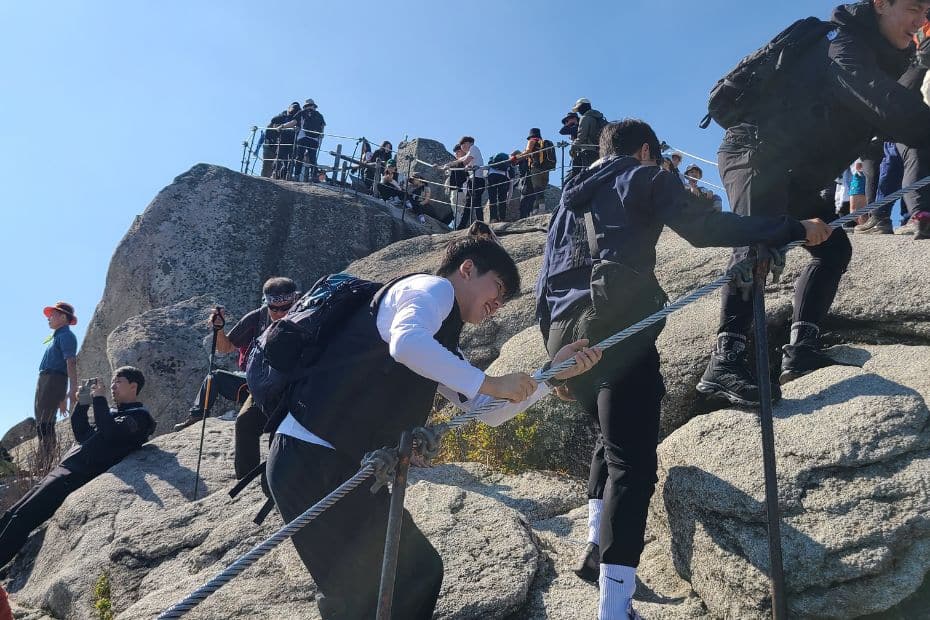
The pictures above were taken on a Saturday in October, which is one of the most popular times to hike Bukhansan. The queue was slow moving and people had to squeeze past each other while trying to hold on to the railing. It’s not comfortable, but the views at the top more than make up for the wait.
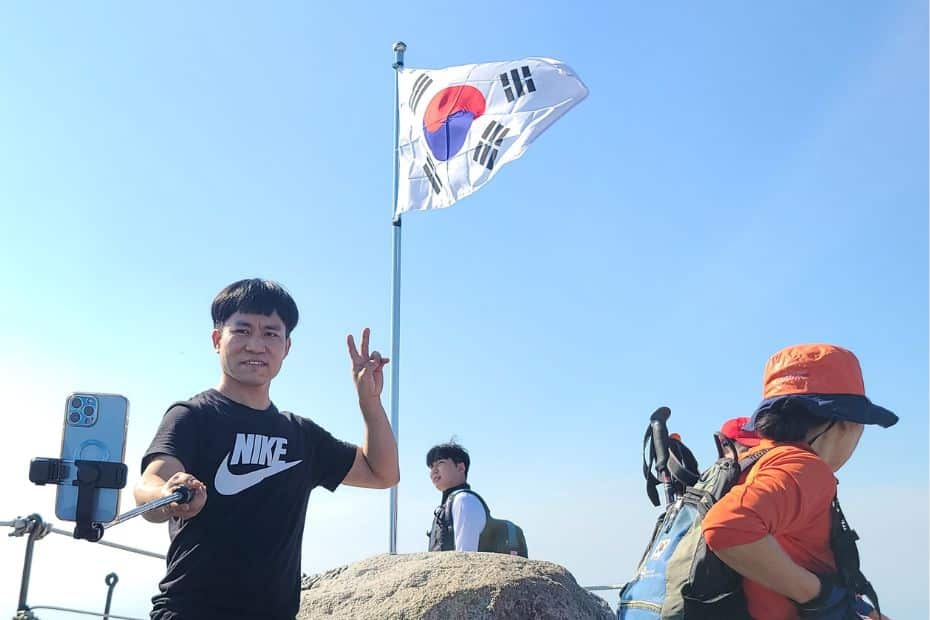
As you can see below, the views from Baegundae Peak stretch out far and wide and you can see all the way over Seoul on a clear day. This is a great place to get a picture to remember your time hiking to Baegundae Peak in Bukhansan National Park. Just don’t expect to be alone on the weekends.
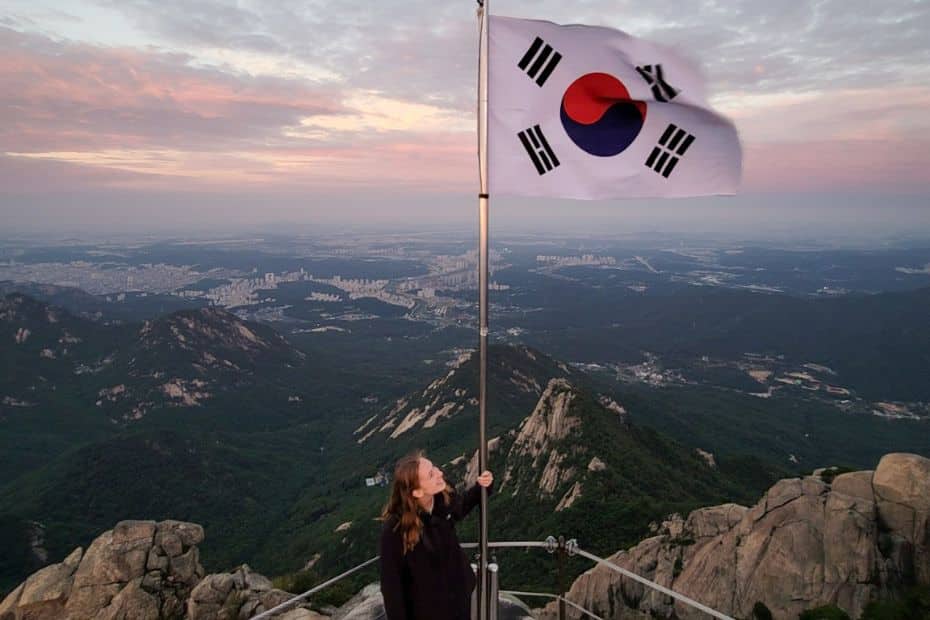
One final thing… there are cats on Baegundae Peak sometimes. Yes, cats love hiking as much as humans. Or perhaps they’re looking for some food from people eating lunch at the peak. Either way, it’s an impressive journey for our feline friends as Baegundae Peak is over 800 metres high.
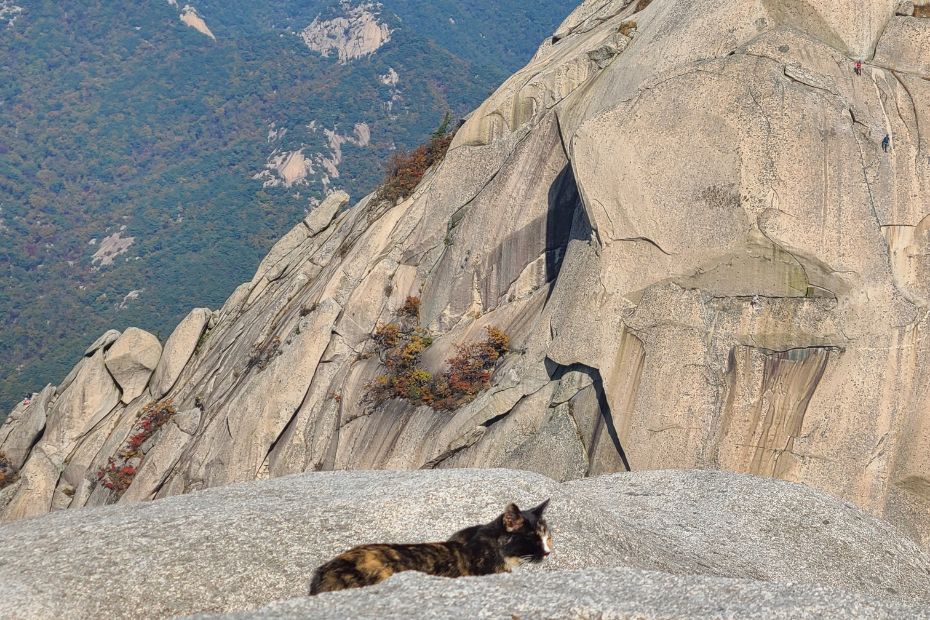
Which Course Should You Hike To Baegundae Peak?
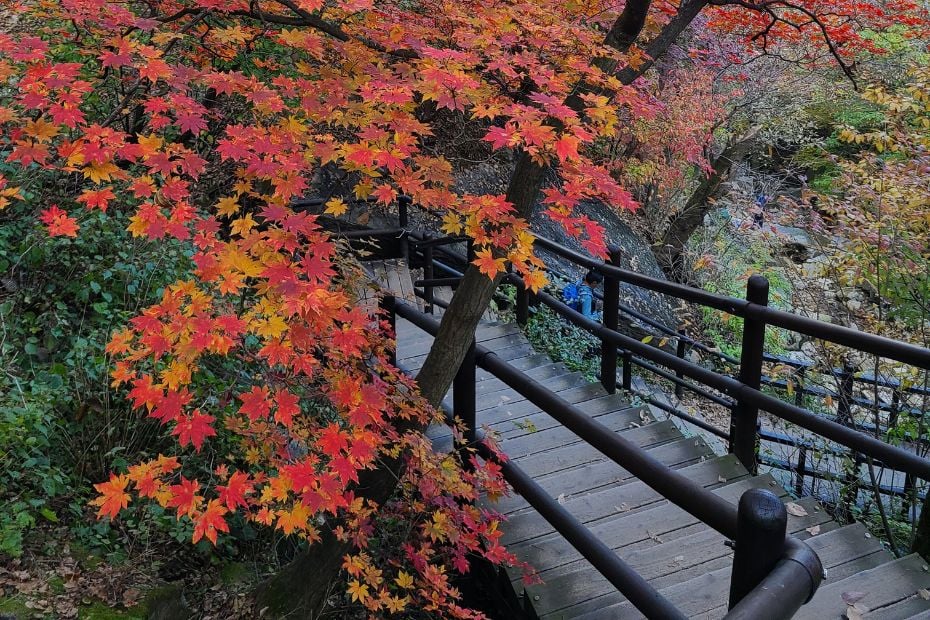
The best route to hike Bukhansan Baegundae Peak is dependent on the amount of time you have available, your physical fitness, the difficulty of hike you want, and what you want to see along the way. All of these courses offer spectacular views, but they differ in other aspects.
Each course provides its own benefits. The first trail I ever hiked was from Bukhansan Fortress Entrance up along the steep trail. At that time I wasn’t in the best of shape and it was hard on the legs, but doable. The accomplishment I felt when I arrived to the top, and the views, made it worth it.
It wasn’t until later that I discovered the longer ‘easy’ trail up from Bukhansan Fortress Entrance. This route is great if you have a whole day to spend on the mountain as you can enjoy the views along the way, as well as from the top. Combining this trail with another trail exposes you to more of the park.
It is possible to go up the shorter route and then back down the longer route, meaning you can still enjoy the views and your knees won’t be an issue on the way down. I would recommend this or the Doseonsa course if you’re worried about hurting your legs or you have problems with your knees.
The trail starting from Doseonsa Temple is the quickest way up and down, along with the route from the Baegundae 2 Ranger Station. These are great trails if you are worried about the steepness or the length of the other trails. Also, this route is great for a sunrise hike to Baegundae Peak.
Below is a hiking map that shows the hiking routes through the southern half of Bukhansan National Park, including hiking routes to Baegundae Peak. You can use this map to help you plan your route from various starting locations to the peak and back down again, including those mentioned.
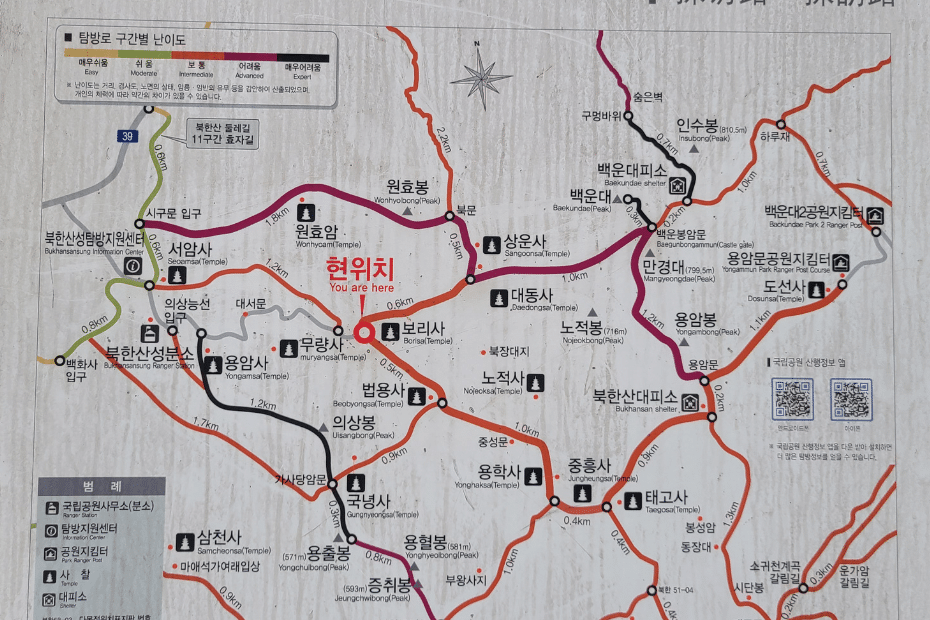
What To Prepare To Hike Bukhansan Baegundae Peak
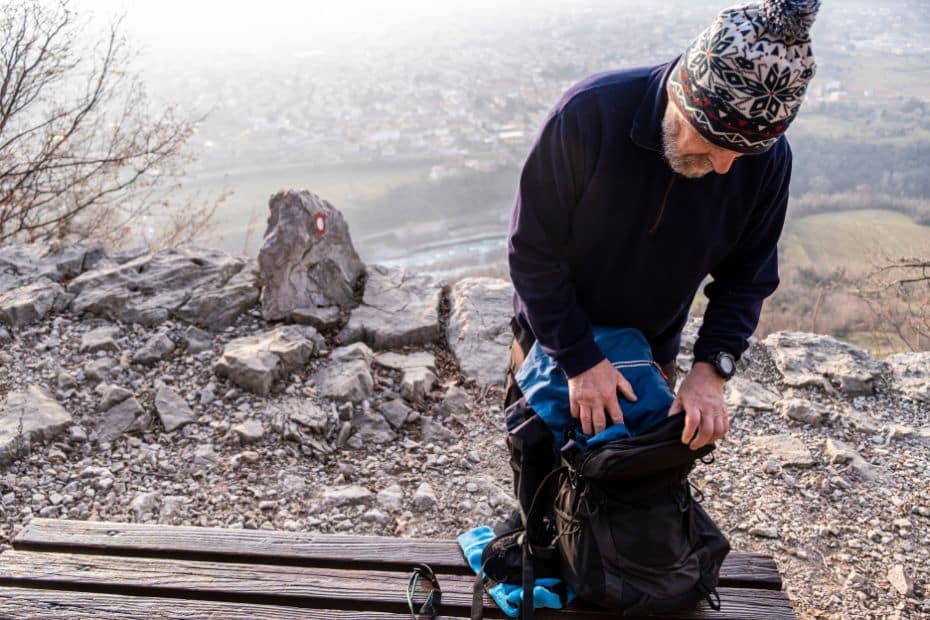
To be fully prepared to hike Bukhansan there are a few things you should get ready before you head out on your adventure. Some of these are essential considerations that you should be aware of before you hike, others are nice extras to think about and can improve your hiking experience.
Choose which trail to hike to Baegundae Peak: Hopefully you’ve already decided which path you want to hike to the peak from the previous sections in this article.
Work out how to get to the trail start point: See the ‘how to get there’ sections above. I also recommend downloading the Naver Maps app as it’s essential for getting around Korea.
Decide when you will go hiking in Bukhansan: There’s something to see in Bukhansan in every season. Visit on a weekday for less crowded hiking trails and avoid hiking in the rain if possible.
Consider what to wear when hiking Bukhansan: From hiking clothes to hiking accessories, it’s good to prepare in advance and make sure you have the right gear any time you hike in Korea.
Pack appropriately for your Bukhansan hike: As well as the right clothes, you’ll need a some hiking equipment, food, snacks, and other supplies to keep you safe and comfortable all day.
Think about what to do when you finish hiking Bukhansan: This final consideration could be the one that leaves a lasting memory and caps off a great day out in Bukhansan National Park
These last 4 points will be covered in the next sections of this guide to hiking to Baegundae Peak. This is really useful info that I’ve gathered through years of hiking, as well as from the odd mistake and accident. Take a note of these sections to make sure you have all you need to enjoy your hike.
Remember, if you’re worried about getting lost while you hike or not sure you want to organise everything yourself, you can book a private tour to Baegundae Peak to take you to the peak, teach you about the park’s nature and history on the way, and make sure you get home safely.
One last thing, when you hike in Korea…
Don’t Forget Your Passport!
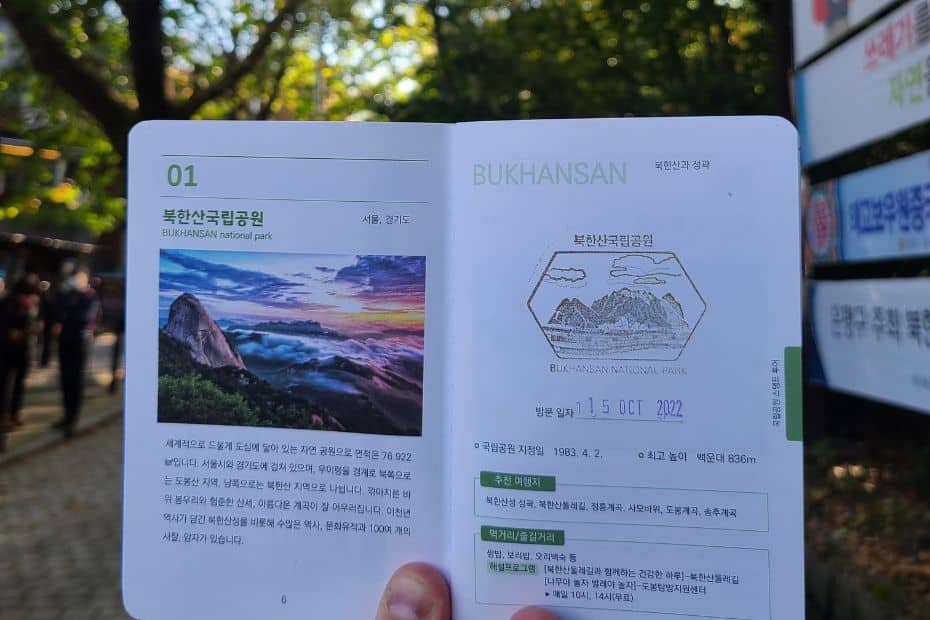
Don’t worry, you don’t need your passport to hike in Korea’s national parks. However, if you want a fun souvenir, or you plan to hike more of Korea’s national parks, why not pick up a National Park Hiking Passport like the one above. You can find them at the entrance to national parks in Korea.
This passport-style book allows you to collect stamps from all of the national parks across Korea, including Hallasan National Park on Jeju Island. If you live in Korea, this is a fun challenge to encourage you to hike all of Korea’s best national parks and see more of the country.
Appropriately, Bukhansan is the first national park you can get a stamp for. Will it be your last?
When Is The Best Time To Hike In Bukhansan National Park?
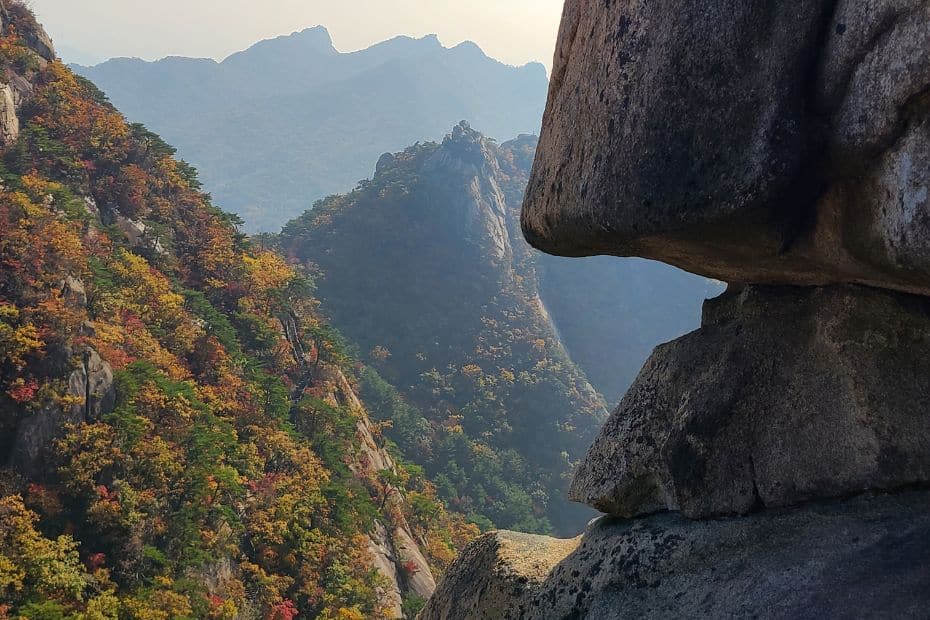
I have had the opportunity to hike Bukhansan in all seasons of the year. For me, the best seasons for hiking are autumn, spring and winter. Summer isn’t a terrible month for hiking, but the heat, humidity, and armies of mosquitoes attacking you make it the most difficult time to hike.
During spring you can see the rebirth of nature after the long Korean winter, with green shoots, colourful flowers, and warm breezes in the air. In autumn you can enjoy walking over crisp Korean autumn foliage that has recently fallen, with views of vivd mountain slopes away in the distance.
However, most people have the same idea as myself and therefore the mountain can be busy during the weekends in these seasons. This is the reason why I like hiking Bukhansan in winter. Fewer people brave the snowy peaks and windy valleys. However, that’s not to say it’s empty.
Although it is a popular mountain, with many people from Seoul and beyond hiking here, during winter the trails are less busy, allowing you to take the hike at your own pace. You can stop to enjoy the views whenever you please. This is also one of the best places to see snow in Seoul when it falls.
The best time to hike Bukhansan is on a weekday (less busy) during April, May, September, October, or early November. In April and May the weather is warm and the forests are full of nature. In the autumn months, the autumn foliage is gorgeous. January and February are good for snow, too.
A Note About Air Pollution In Seoul
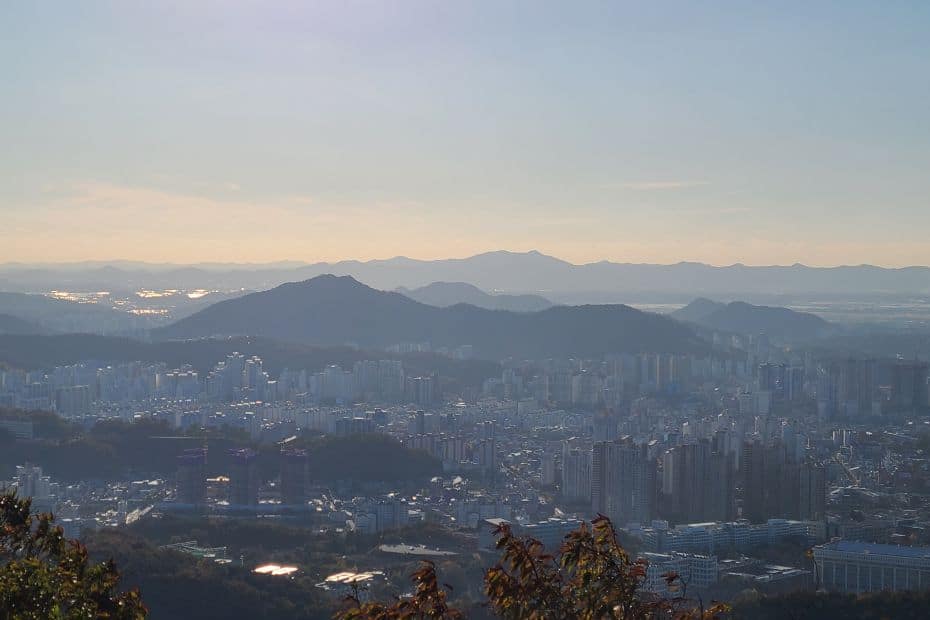
If you plan to hike in late winter or spring, you should check the air pollution levels. Unfortunately, this is a problem in Seoul and across Korea throughout the year, but is most noticeable at these times. If you have a sensitivity to air pollution, bring a mask or postpone the hike for another day.
Most of the year the air pollution isn’t at serious levels, but it peaks around March and April due to seasonal winds blowing yellow dust across from Mongolia and China. During these seasons, the air pollution, known as fine dust, may ruin the views and be hazardous for your health.
Check an air pollution website or app like AQICN to check the latest pollution levels and to get a pollution forecast for the week ahead. If the pollution levels reach over 200, it might be best to postpone your hike for a clearer day. Air pollution is usually lowest after it has rained.
What To Wear Hiking In Bukhansan National Park
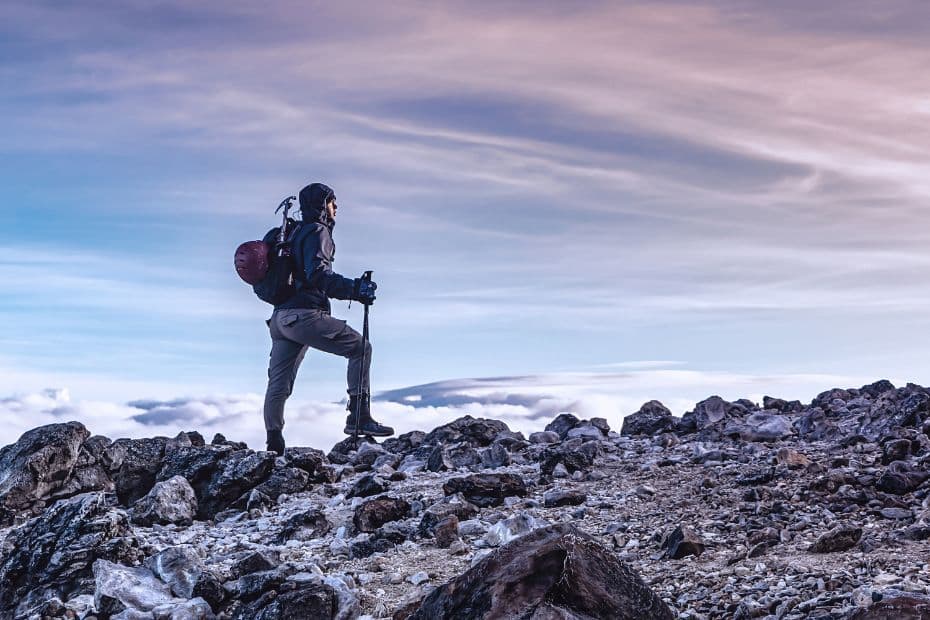
Once you’ve figured out what time of year you want to hike Bukhansan Baegundae Peak, you should pack the right clothes for the season. Of course, the weather in Korea can change day to day, so also bring appropriate clothes for the weather that day (i.e. a raincoat if it’s raining).
No matter the season you should wear hiking boots and if this is not possible a good pair of sneakers will do. In the past people have chosen to wear other forms of footwear, however, it is recommended to wear something sturdy that will support your ankles and provide cushion when you are walking up.
It is important that what you wear is comfortable and doesn’t restrict your movement. If it is likely to rain you should consider waterproof trousers or trousers that won’t cause friction when wet. When hiking it is always good to have layers to add or remove, even in winter when you get hot hiking uphill.
In summer you may want to wear a t-shirt, but a wind breaker or something with long sleeves may be necessary for when you are on the top of the mountain. It is a similar situation in other seasons. A fleece, vest, windbreaker or coat (in winter) to add to the layers you are wearing certainly helps.
For the hike to Baegundae Peak I would recommend taking gloves, these could be helpful in all seasons when climbing up the section with metal railing and rope. Sweaty or cold hands can make it difficult to grip onto the supports, therefore wearing gloves can be a life saver.
Hiking Clothes For Different Seasons

In terms of what to wear hiking in Korea during each season, here’s a rough guide to what to pack:
Spring & Autumn: These seasons are warm with a few showers, but not heavy rain or snow. Dress lightly as you’ll be hot going up the mountain, but also pack a light jacket for the peak as it can get windy and cold up there. You’ll also be cooler going down after reaching the summit.
- Top: Light top.
- Jacket you can store in your bag.
- Legs: Light trousers to protect from insects.
- Feet: Regular hiking socks.
Summer: Summer in Korea is hot and humid and the wettest season. I recommend light clothes for hiking in hot weather. Cover your arms and legs to avoid mosquito bites and reduce the chance of sunburn. Pack a poncho (sold in the parks during summer) or light waterproof jacket in case of rain.
- Top: Long-sleeved thin hiking or cotton t-shirt.
- Rain jacket or rain poncho if raining
- Legs: Long shorts or trousers to protect against mosquitoes.
- Feet: Ankle socks.
Winter: The winter months in Korea can be very cold, well below freezing, so wrap up warm. However, you’ll heat up as you hike, so also wear clothes that you can shove in a bag or wrap around your waist. Insulated socks and inner wear are recommended if the weather is far below zero.
- Top: Layers that you can remove easily.
- Jacket with wind protection, thin fleece.
- Legs: Thick or lined trousers (with leggings if really cold).
- Feet: Woollen hiking socks.
Headwear: A cap or a wool hat can be important on a hike to protect yourself from the sun or to keep you warm as the temperature drops. This applies to all seasons as you can be get sunburn in any season, even winter. Bring a cap for summer and wool hat for winter to help keep heat in.

Hiking boots: A decent pair of hiking boots is the best investment you can make when hiking. I use the same pair most of the year round (except summer) and they keep my feet and ankles safe and protected from injury. They also help me in bad weather conditions as they provide sturdy grip.
- Recommended hiking boots for women.
- Recommended hiking boots for men.
Tip: Bringing a pair of comfortable hiking boots with you when you visit Korea can be useful for more than just hiking. Travellers end up walking a lot – around palaces, in hanok villages, outside temples, and along countless streets. Hiking / trekking boots will keep your feet cosy while you explore, too.
For more info about what to wear, pack, and prepare for hiking in Bukhansan or other Korean national parks, check out this guide to hiking in Korea. There are more than 20 hiking tips that will make sure you have a great day out in the mountains (weather not guaranteed!).
What To Pack To Hike Bukhansan Baegundae Peak
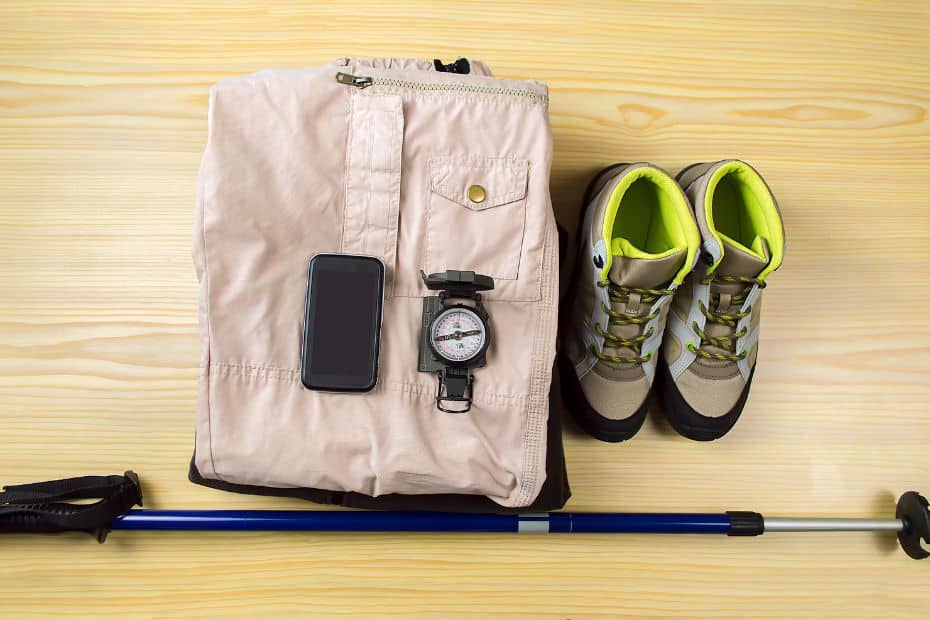
What should you pack to hike Bukhansan Baegundae Peak? As mentioned, for your Bukhansan hike it is important to take extra layers and clothes that will keep you warm. Depending on the season you will add different items to your bag, but extra layers are something you should always consider.
Food And Drinks For Hiking In Bukhansan
No matter the route you take up to Baegundae Peak, you should pack some snacks, water or other liquids, and possibly a lunch in your bag. Nut bars and fruit are always a good snack to give you some energy on the mountain. For lunch, buy a gimbap or sandwich at the entrance to eat at the peak.
Water, or your choice of hydrating drink, is a must when hiking. Depending on the season, the amount you need to drink will differ. In winter a 500ml bottle may be enough, but if you hike in summer, you’ll need at least 1 litre or more as you’ll lose a lot of liquids through sweat in the high heat and humidity.
My Hiking Supplies
Here’s what I usually pack in my bag when I’m hiking for four hours or more:
- fruit (apple or banana)
- vegetables (tomatoes, sliced peppers, sliced carrots)
- trail bars / energy bars
- small bag of nuts
- gimbap (Korean-style sushi roll)
- 1l of water
- 1 bottle of Powerade
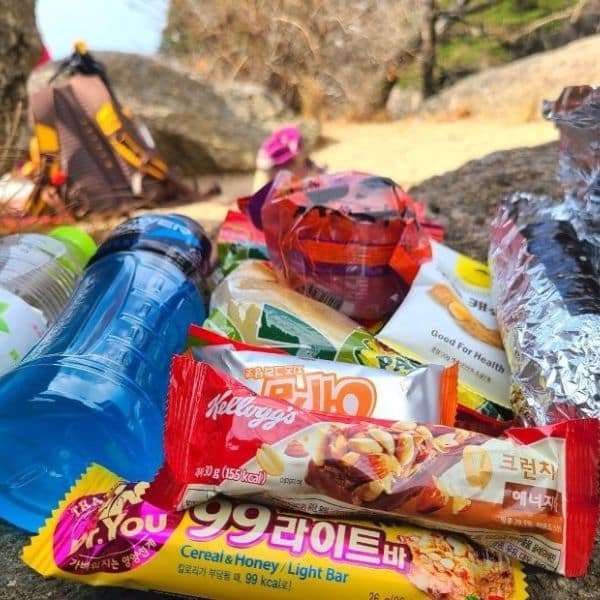
Hiking Equipment For Hiking In Bukhansan
Even though you’ll want a light backpack when you hike Bukhansan, there are some essential items that you should bring whenever you hike, such as hiking poles, tissues, a sweat towel, and gloves. These items can change depending on the season, but most are essential for any hike.
Backpack or daypack: You’ll need something light to carry your snacks, water, and equipment with you when you hike. For a day hike, you shouldn’t need more than a 25 litre backpack.
Reusable water bottles: If you want to reduce your environmental impact, bring some collapsible or reusable water bottles with you and fill them at the water fountains at the park’s entrance.
Hiking poles: These extendable hiking sticks are great for getting over rocky paths and for improving balance while reducing leg pressure while descending the mountain. Not essential for everyone.
Sun protection: Baegundae Peak is exposed with no chance of shade, and some of the paths near the start of the hike are also unprotected. Be sure to apply suncream and wear sunglasses.
Sweat towel or handkerchief: Whatever season you hike Bukhansan in, you’re probably going to sweat a bit (or lots). A sweat towel or handkerchief is also useful for drying your hands.
Insect repellant: From spring to autumn, you will find mosquitoes in the mountains. Be sure to spray yourself before hiking Bukhansan. Summer is the worst period for insects while winter has none.
Hygiene supplies: This includes tissues, wet wipes, and hand sanitiser. Tissues and wet wipes have many uses, including cleaning your hands before you eat or if you need to use a toilet.
First aid kit: This isn’t necessary, but can be useful if you’re concerned about cuts and scrapes while you hike. I usually have a few plasters in my bag in case I cut myself on a thorny bush.
Cash & T-Money card: Bring some cash to use at the food stalls or vending machines at the national park entrances and other locations. Use a T-Money Card for public transportation to the park.
What To Bring For Hiking Bukhansan In Winter
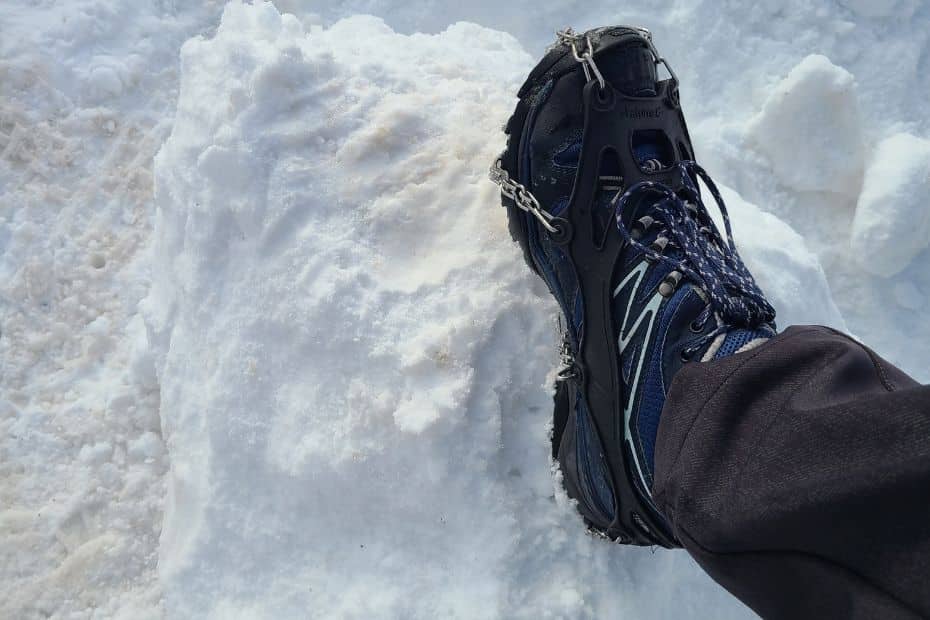
The following items are hiking equipment you might need if you plan to hike in winter when snow and ice can build up on the hiking paths of Bukhansan.
Crampons / cleats: Even if the start point doesn’t have ice or snow, there certainly can be some at the peak. Pack some cleats to slip on when it gets icy to stop you from slipping and injuring yourself.
Windproof hiking gloves: Temperatures in winter get below zero and as you hike to Baegundae Peak, the temperature will drop even more. Windproof, waterproof gloves will keep your hands safe.
Sunglasses: Winter in Korea is the sunniest time of the year and the sun can be blinding as it reflects off the snow or ice. Definitely bring shades if you plan to hike Bukhansan in winter.
Heat packs: Hand and foot warmers or heat packs to stick on your clothes are both really useful for hiking in Korea during winter. I always pack hand warmers for my pockets to keep my hands alive.
Rent Hiking Gear From The Seoul Hiking Tourism Centre
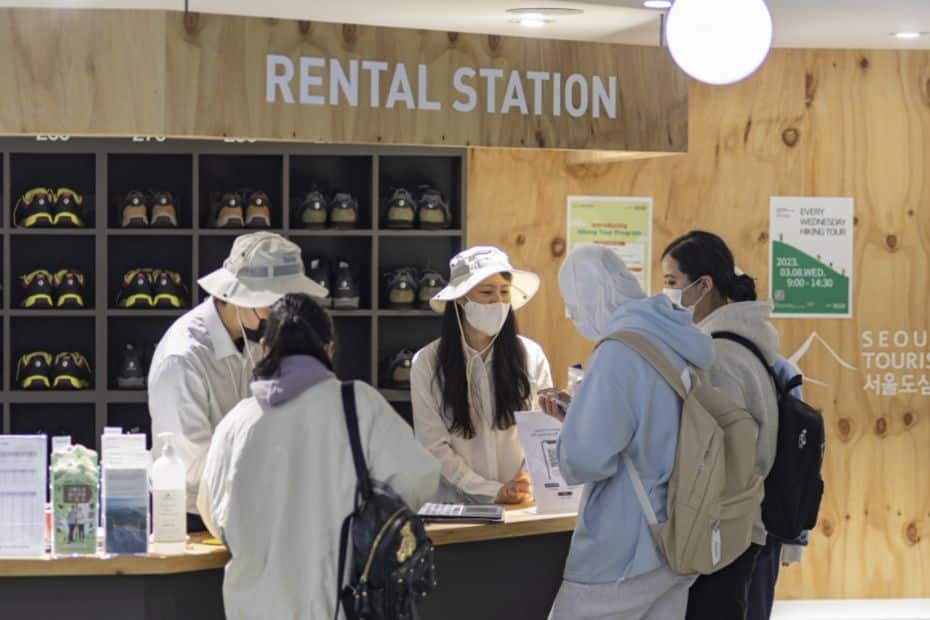
Don’t want to bring your hiking equipment with you when you hike? Good news, you can rent it from the Seoul Hiking Tourism Centre. Located close to the Bukhansan Ui subway station, this tourist-friendly centre allows you to rent clothes and equipment for the day for your Bukhansan hike.
You can rent everything you need, including hiking boots, jackets, poles, trousers, and shirts. Prices are very reasonable and can be a great solution if you plan to hike Bukhansan but you forgot your gear or chose not to pack it. Please note: You need to reserve gear in advance from their website.
There are also free guided hiking tours on Wednesdays for various hiking routes in Bukhansan, including hikes to Baegundae Peak. There are also hiking and trekking courses that change each month, focusing on some special feature in the park during that month, such as autumn foliage.
Address in Korean: 서울특별시 강북구 삼양로173길 52 5층
What To Do After Your Baegundae Peak Hike
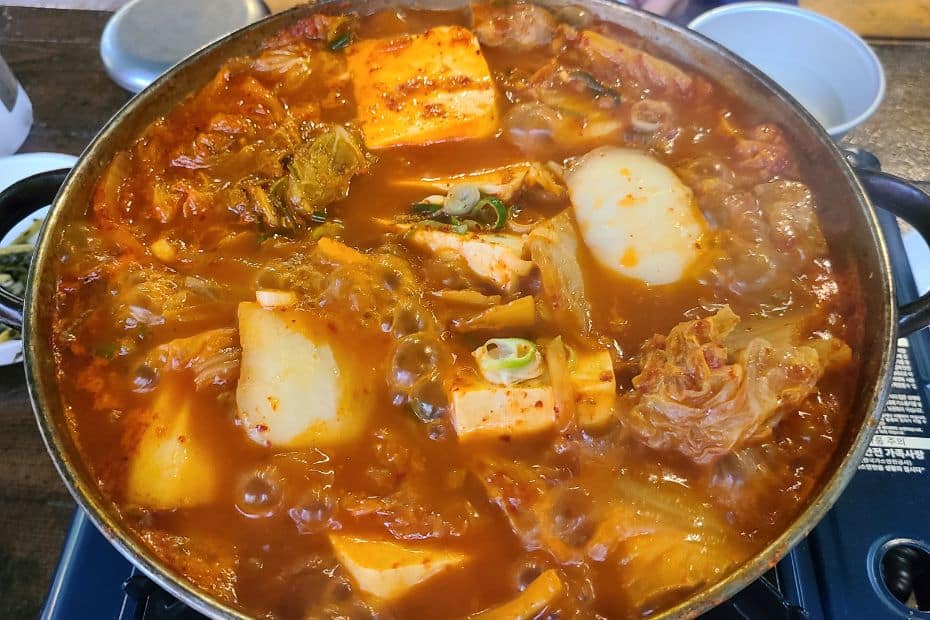
After you finish your hike to Baegundae Peak, there is still lots to enjoy in Bukhansan National Park. Whichever route you choose to hike down, you will find restaurants selling delicious Korean food, including the hiker’s favourite – haemul pajeon (seafood pancake) and makgeolli (Korean rice wine).
There are also restaurants that serve other dishes, such as kimchi jjigae (kimchi stew), samgyetang (chicken soup), or dalkdoritang (spicy chicken stew). If you don’t feel like traditional Korean food, there are some cafes in the area, too. You can sit and enjoy the final scenes of Bukhansan’s nature.
You’ll find Korean restaurants and cafes at both ends of the Baegundae Peak hike. There are more restaurants at the Bukhansan Fortress Entrance, but I prefer the restaurants along the road from the end of the Doseonsa / Baegundae 2 Ranger Station courses. These are more authentic and quieter.
If you’re interested in hiking more of Korea’s national parks, then perhaps you’d enjoy hiking in Seoraksan National Park on Korea’s East Coast. There are several hiking trails, as well as a cable car, famous temples, a giant bronze Buddha, and great places to eat and drink with mountain views.
What To Eat Near Doseonsa Temple Entrance
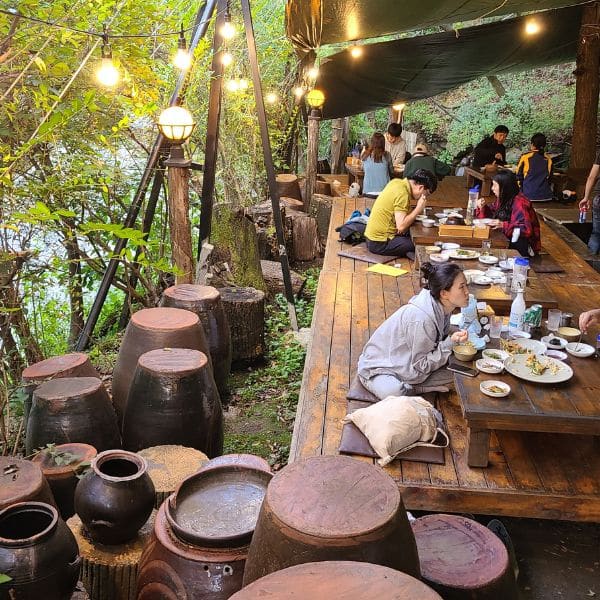

The pictures above are taken from San Restaurant (산 음식점). You can find amazing traditional Korean dishes here with a selection of traditional Korean alcohol, including makgeolli and dong-dong-ju. I highly recommend you stop here for a haemul pajeon (serves 2) with a bottle of makgeolli or two.
San Restaurant Address: 서울특별시 강북구 삼양로173길 207
Opposite San is another traditional restaurant called Seonun Sanjang (선운산장), which sells bulgogi (grilled beef) with lots of banchan (Korean side dishes). This is a great place to try a traditional Korean meal that’s best shared with others. Another good option is Gaenari Sanjang (개나리산장).
If you finish the course at the Doseonsa Temple entrance, you will need to walk for about an hour to Bukhansan Ui station, which is the departure point for both the subway and buses into other parts of Seoul. You’ll find restaurants and cafes in this area, too. Not as authentic, but still good for dinner.
Tip: If you don’t want to walk for an hour from the temple entrance to Bukhansan Ui station, you can use Kakao Taxi to call a cab to come and pick you up. However, taxis might not want to go all that way before collecting you, so don’t count on this as a guaranteed option.
What To Eat At Bukhansan Fortress Entrance
The Bukhansan Fortress Entrance area is admittedly a much more convenient location to end your hike and has a wider selection of cafes, restaurants and shops to visit. There are dessert cafes, selling Korean desserts such as the unique Bukhansan Montblanc (pictured below) and other treats.
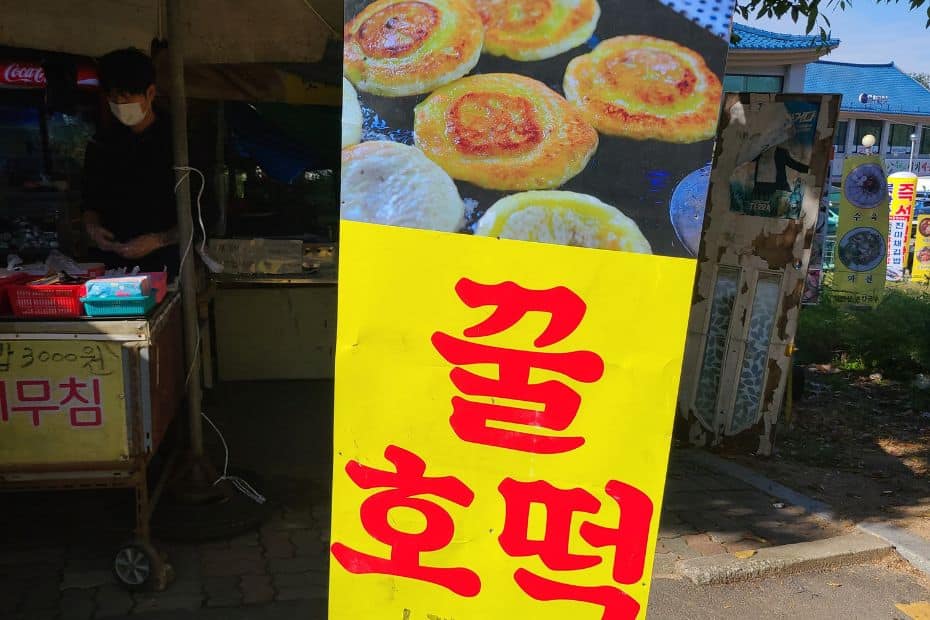
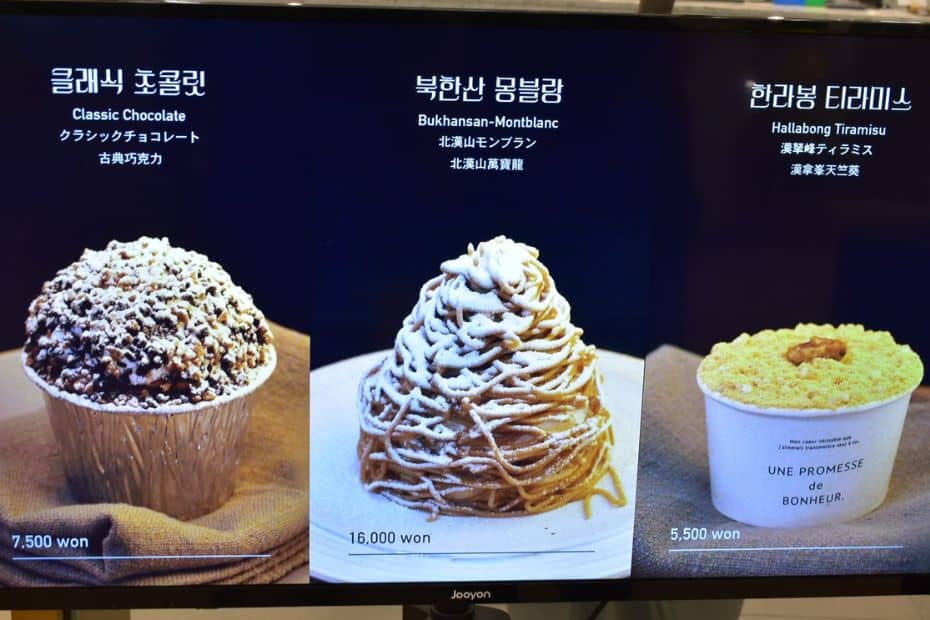
If you feel hungry, I recommend trying a ggul hotteok (꿀호떡) – a traditional Korean winter street food that’s popular with hikers. A ggul hotteok is a sweet Korean pancake that’s filled with ingredients such as honey, nuts, seeds, and cinnamon. Ggul is the Korean word for honey, so expect a sweet taste.
Want to try some spicy Korean food? Head to Bukhansan Megi Maeuntang (북한산메기매운탕), which serves megi maeuntang – a spicy stew made of freshwater catfish that has lots of vegetables and side dishes. This isn’t a meal for solo hikers as the smallest portion serves 2. Try it with friends.
Rest And Recover At A Korean Sauna
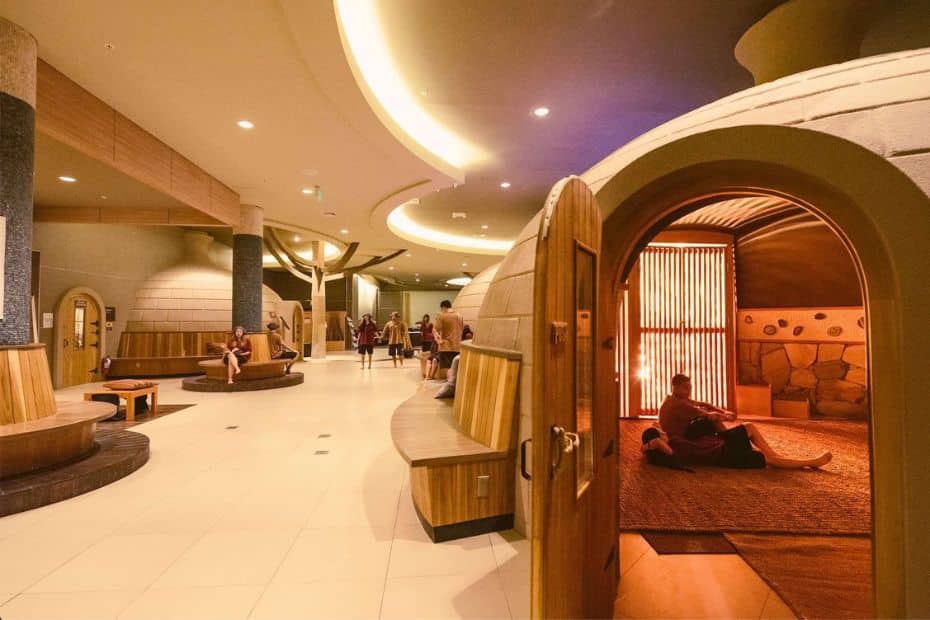
After hiking to Baegundae Peak, you deserve to rest and relax and to let your body heal. One of the best ways to do this is at a Korean jjimjilbang (sauna and communal hot room). These saunas are typically split into two sections – one with hot water pools, the other with communal rooms.
The hot (and cold) water pools are great for soaking and resting weary bones. There are also steam rooms and Scandinavian-style saunas with wooden benches to squeeze out the last bit of sweat in case hiking wasn’t enough for you. This area is gender-segregated and everyone is naked.
In the communal rooms you will find sleeping mats, heated domes (pictured above), TVs, singing rooms, food and drink counters, and other facilities. These rooms are for chilling in and you can also spend the night here. These areas are mixed and everyone should wear pyjamas.
There are many spas and saunas in Seoul, and these are known as ‘saunas’ (사우나) or ‘jjimjilbangs‘ (찜질방). If you want to find one in Seoul, try searching for ‘사우나’ as this is the more common name for these saunas. Some saunas might not have the communal rooms and will only have baths.
How To Hike Bukhansan Mountain FAQs
Finally, here are a few FAQs about how to hike Bukhansan Mountain in Seoul, in case the above information didn’t cover enough for you. If you have any other questions you’d like to ask, feel free to leave a comment.
Is it hard to hike Baegundae Peak?
There are several hiking routes to Baegundae Peak, including the Baegundae Peak Difficult Course and the Baegundae Peak Easy Course. These two routes provide a short but difficult option and a longer yet easier option to get close to Baegundae Peak. However, the final ascent for both routes, which meet before the peak, is considered ‘expert level’ and is the hardest part. The final ascent is only 300 metres, so any reasonably fit hiker should be able to complete it.
How long does it take to hike to Baegundae Peak
The shortest route to Baegundae Peak starts near Doseonsa Temple and takes between 2.5 to 3 hours to complete from start to finish. Active hikers may be able to complete the hike in a shorter time. The hike to Baegundae Peak from the Bukhansan Fortress Entrance takes longer and lasts for 4 to 6 hours, depending on the route taken.
Which trail is the easiest to hike in Bukhansan National Park?
The easiest trail in Bukhansan National Park is the dulle-gil trekking trail which goes around the outside of the park. This trail is suitable for all levels and doesn’t go into the mountains so trekking shoes are adequate for this route. The easiest hiking trail to Baegundae Peak starts at Doseonsa Temple.
Which is the best Hiking Trail in Bukhansan National Park to get to Baegundae Peak?
The best hiking trail in Bukhansan National Park to reach Baegundae Peak is the Baegundae Peak Difficult Trail which starts at the Bukhansan Fortress Entrance. This route provides a challenging hike to Baegundae Peak with views over Seoul, passing by several temples along the way. Descending on the opposite side of the park towards Doseonsa Temple offers a good alternative to hiking the same route as the ascent.
Is Bukhansan National Park easy to reach from Seoul?
Bukhansan National Park is the only national park located inside the Seoul city limits and is accessible by public transport, including buses and subways. Bukhansan Ui subway station is the best way to enter the national park from the east. The western entrance, known as Bukhansan Fortress Entrance, is easily accessed by bus 34 or 704 from Gupabal subway station.
Can you see autumn foliage When you hike Bukhansan National Park?
Bukhansan National Park is one of the best places in Seoul to see autumn foliage in October. The hike to Baegundae Peak allows hikers to pass under autumn foliage, including colourful maple trees. From the peak, hikers can see mountainsides full of fall foliage and is one of the best autumn scenes in Seoul.
What is the main peak of Bukhansan National Park?
The main peak of Bukhansan National Park is Baegundae Peak. This is the tallest peak in the national park and is one of the most popular for hikers to ascend. There are several hiking trails to Baegundae Peak that approach from the west and east. The peak can be reached in under 2 hours from certain starting points.
Liked This? Pin It For Others
If you enjoyed reading this article, then please share this with your friends on Pinterest.
